Reaching 30 is such an arbitrary milestone, and I had not planned on being alive for this long. I barely remember what happened before I turned 20, and somehow I have managed to stumble my way through another decade. As arbitrary as it is, I figured I'd write this post documenting my life and learnings about myself over the past ten years. This will also be my longest and most rambly blog post ever and was not meant for anyone else but me to read.
To make my life easier for future reference, I’ve added hyperlinks to the various sections in this table of contents. The sections that are extra long will also have their own table of contents at the top of the section. There will also be links under the headers that link back to the subheader and the main table of contents.
-
Why I started a blog
My journey with posting my thoughts online.
-
A timeline of notable events
An overly detailed year by year recount [long]
-
Tracking my life
All the things that I track and how it’s been going so far [long]
-
My relationship with motivation
How I’ve dealt with motivation throughout the years
-
Tricking myself into exercising
All the ways I’ve tried to get myself to exercise [long]
-
Overcommitting to everything
Not knowing how to say no, not knowing when to stop
-
Notable Failures
A non-exhaustive list of projects and goals that haven’t made it to fruition (yet?) [long]
Why I Started This Blog
back to topI used to believe that opinions should be kept to oneself (ironic coming from an opinion post, yes, but I've never really imposed this belief on others). This belief was mainly formed by how I was shown how things one posts online would be used against them in the future. Because of that, I felt some disdain for people posting their opinions on blogs and other forms of social media. Why express your views when you can keep them to yourself and never get into trouble? I actively avoided being on Facebook and kept my online presence pretty low.
When I eventually had to create a Facebook account, it was for my school to disseminate information to us. I still barely even used it and relied on friends to tell me what I missed. Blogs were equally on my shitlist as well. My image of blogs was that of angsty teenage ramblings, and I had no wish to contribute to the ramblings of the world.
Crafting an online presence
Sometime in 2012, I started to think of my online presence as more of a brand identity for would-be employers to find. In fact, this was initially why I didn't want to have an online presence so that I would not lose a job over my past stupid actions. That's when I realised that I could craft an online presence that I wanted people to see if I was deliberate about it. If someone were to search for me, it would be good if they saw my blog, where I geek out about cool projects I work on. It's not like my name is terribly common either, so I wouldn't need to worry too much about doing SEO against other Jia Xuns.
Logging my interests and hobbies
Another reason I made the blog is to have a space to practice my writing and have a way to log all the interests and hobbies I've gone through over the years. It's one thing to keep backups of your projects, but it's another thing also to have some commentary to look back on and see what you were like all those years ago. I guess this is why people keep diaries, but I was never huge on physically writing anything down. I would often lose books or damage them, and writing also hurt my hands.
Sharing my ideas with friends
One last use case for a blog is that I would often go into long rambles and rants about a cool new thing that I had come across or a new idea I had to my various friends. Each subsequent time I brought up the topic, I noticed that I would progressively leave out more information and lose the energy and drive to talk about it. Having a space to pen it down and then a permalink I could send to my friends was always nice to have.
This post will not have the best structure as it's mostly just a brain dump of all the things that I've done over the past ten years. The intended audience is mostly me in the future. Still, I've put it up here for anyone to see and use against me in future internet arguments.
A Timeline of Notable Events
back to topI tried as hard as I could to remember all the things that happened to me over the years. It's quite a coincidence that I started backing up my photos in 2011, so going through them has allowed me to form a detailed recount of the past ten years. I've grouped the events by year in this section. My sources primarily include my (failing) memory, my projects archive, and Google Photos.
- 2012 (20 years old) - Entered the Military
- 2013 (21 years old)
- 2014 (22 years old) - Started University
- 2015 (23 years old)
- 2016 (24 years old) - Yearlong Internship in US
- 2017 (25 years old)
- 2018 (26 years old) - Started Jobbing in US
- 2019 (27 years old)
- 2020 (28 years old) - Pandemic
- 2021 (29 years old)
- 2022 (30 years old)
2012 (20 years old)
back to section top- Final Year Project
- Poly Graduation
- Contract Work
- Time waste (National Service)
- Lost a lot of weight in Basic Military Training
I turned 20 in May of 2012, in the last year of my polytechnic diploma. The beginning of the year was spent working on my final year project and school project showcase. Sometime after that, I graduated with a diploma. I attended my first and last graduation ceremony. (I refused to participate in my uni one because this one showed me how boring it can be).
While waiting for my enlistment, I worked at my internship company for a couple of months to get some money. I enlisted on 4 September 2012. I remember crying every night for the first few weeks. I refused to eat much, partly because the food sucked, and I was too tired. There was plenty of exercise, and I also fell sick. As such, I ended up losing 15kg in the first two months due to a combination of training and mild malnourishment. Overall, I would rate the experience 0/5, but 5/5 for a weight loss program. I did gain back 5kg to be a more reasonable weight over the coming months.
I can't remember much else from this year since I hadn't been taking many photos at this point.

2013 (21 years old)
back to section top- Time waste
- Drive Armoured Vehicle
- Pencil Drawings
- Thailand military exercise
- Learnt to fly a drone for a video shoot
- Created YouTube Videos for a client
I also don't have too many photos from this time. For the most part, because I can't take photos in camp. The only thing I remember from this time was how much I hated wasting my time when I could be doing something else more productive.
I did still try to be more productive, though. I had installed an android app that let me code and compile Android apps directly on my phone. It was pretty amazing, and I spent the free time I had at night secretly coding on my phone (we weren't allowed to use our phones after lights out). There is also a lot of free time during the day in the military. There is only so much you can exercise and pretend to look busy. Since we weren't allowed to take photos, I started to draw during this time. This was the closest thing I had to a camera that I was allowed to do anyway.
I also learnt to drive an armoured tracked vehicle at this point. I'd put pictures of it, but again, no photos allowed.
At least we were still allowed to go out on weekends, though, and at least I managed to get stuff done. I learned to fly a drone to shoot videos and took on freelance video projects during this time. Drones had minimal auto flight capabilities, were quite hard to fly, and didn't have a live video feed in this age. We had to make some heavy modifications to get a live view to see what we were filming. One of the more memorable videos was called MP3 Experiment. It was a flash mob at Sentosa where I got to fly over a large crowd of people. Shortly after, when the government started passing laws on drone operations, flying in populated areas got banned. I’m quite fortunate I managed to get this experience before the crackdown.
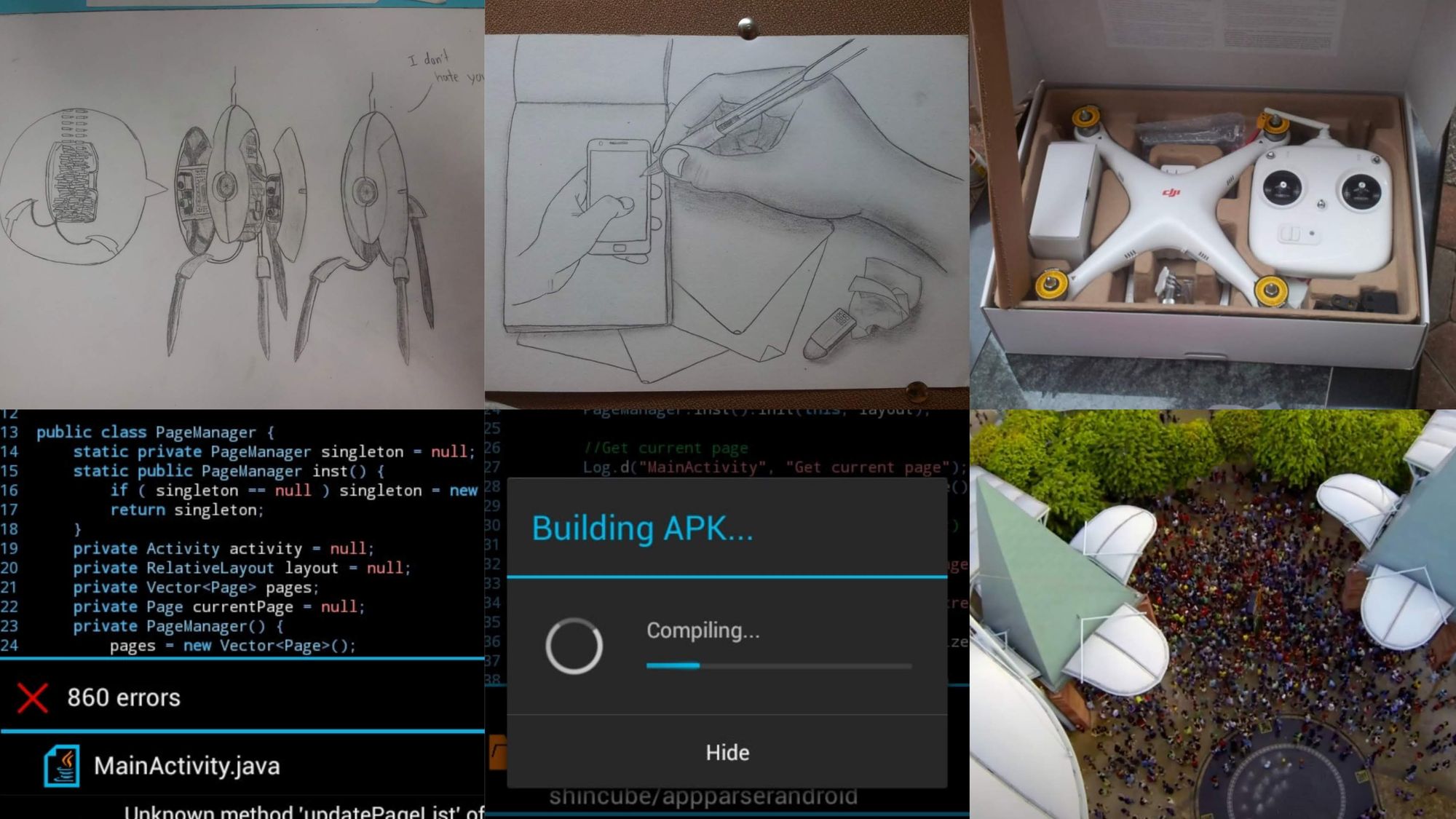
2014 (22 years old)
back to section top- Thailand military exercise again
- First-ever Mountaineering Trip in South Africa
- Rode a horse
- More video projects
- Crashed my drone into the supertree
- Ending my NS
- Started University
- First smartwatch running on Android (Omate)
- Got my first Arduino Kit
Most of this year was a blur since a lot of my time was still spent in the military. The only notable thing I remember from my service is that I went back to Thailand again for yet another military exercise.
Shortly after, I headed to South Africa for my first-ever mountaineering trip. I figured that since I had gained so much additional fitness, I might as well make use of it. I even made long backpacking trips with big heady loads around Singapore to train my physical endurance for the hike. I was quite confident that I'd be fit enough to do a 5-day hike by the time I went on it. It turns out I was completely wrong; I was exhausted 30 minutes into the hike. I later realised that the muscle groups used to walk on flat ground are different from the ones used to hike. I suffered through the 5 days of hiking. During that trip, I also rode a horse for the first time (after the hike, not during).
During the weekends, I continued to take on video projects with my cousin. We filmed a variety of things, from hidden camera social experiments to feel-good videos like performances at the train stations that were eventually played on the platform screens for a while. I also crashed my drone into the Gardens By The Bay Supertree during the MP3 Experiment 2014 filming session (this was before drones were banned everywhere).
The highlight of the year should have been ending my service going to uni. Except that I got so badly destroyed in school since I had lost the ability to study after 2 years of brain rot. So I'm not sure if I would consider this a happy or sad event.
Another notable thing was that I got my first Kickstarter android smartwatch (this was before smartwatches were a thing). Why was it notable? I had bought into their marketing and ordered 5 for myself and my family, and this was at a time when I was a poor uni student. It was the coolest thing ever to have a complete Android phone with a camera on my wrist, and I was quite happy with it overall. Finally, I bought my first Arduino kit, paving the way for me to become a maker.
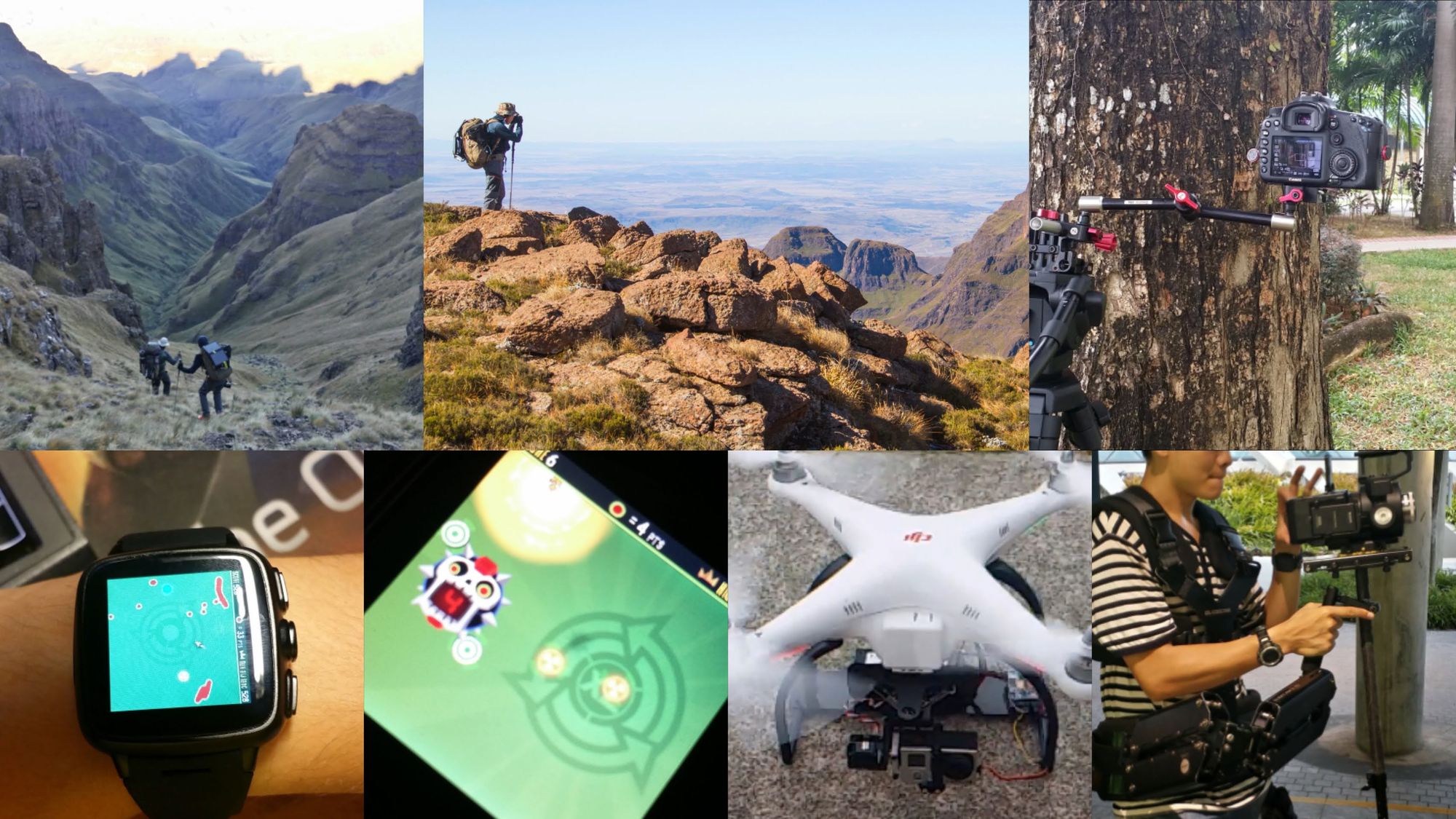
2015 (23 years old)
back to section top- Got into bitcoin mining
- Skating
- French Alps
- Japanese Alps
- Started this blog
Bitcoin was all the rage at this point, so I figured I'd try mining it. I bought one block eruptor and set it up on a raspberry pi. It got me about $0.30 after three months after I spent about $100 on it. I learnt my lesson, and I never touched crypto again (just kidding, I went on to lose many more thousands over the years).
High on my newfound crypto wealth, I went on 2 separate mountaineering trips. One to the French Alps and one to the Japanese Alps. Both of these trips were amazing in their own right but were also failures.
The first trip was a 5-day traverse to Mont Blanc and back, but due to bad weather and zero visibility, we had to cancel that and only do a few hikes. I even brought a stupid heavy drone up there, and all I got was a couple of drone shots. I then had to pay about €1.2k for overweight baggage (which was more expensive than a 2-way ticket). So those shitty shots cost me about €600each. Separately, I lost a few hundred in tax refunds because of incorrect paperwork. Lesson learnt: French service staff really do not care about you if you're a stupid foreigner.
The second trip was supposed to be a 5-day traverse to Mount Yari. I brought my brother and friend, both of whom did not have proper waterproof gear. It ended up raining, and they almost died of hypothermia because being wet at 0 degrees is not great. We survived the night but needless to say, we cancelled the rest of that trip.
Near the end of the year, I joined the skating club and learnt to inline skate. I'm pretty proud of myself because I figured out how to skate in about a week. All it took was crashing a bunch of times, but wounds heal eventually.
I also started writing this blog then.

2016 (24 years old)
back to section top- USA Internship and Exchange Program
- Bought my first car, then learnt to drive (yes, in that order)
- Started Krav Maga
- Attended my first Comicon
- Attended my first baseball game
- Attended my first concert
- Attended so many tech conferences
- Won my first hackathon
- Ran my first half marathon
- Attended my first Maker Faire
- Attended my first DEFCON
- Hiked Patagonia
Quite a lot of things happened this year. I think it was the first time I had ever gone overseas without my family. It was for a one-year internship with UpGuard, where I got my first taste of what it's like to be a real software engineer. I even wrote a blog post about that. We also took some courses with Stanford, which allows me to shamelessly put the "Studied at Stanford" badge on LinkedIn.
One of my proudest moments is that I managed to buy a manual car off craigslist for $1300 without knowing how to drive it. Then I learnt to drive it. I had no license prior, but I managed to figure it out during my daily commute to work. (Yes, I did it legally with a provisional license). Then when I went back to Singapore, I converted it to a Singapore licence. So the cost of my car + conversion fees was cheaper than getting the license in Singapore the usual way, which would typically be about S$2000.
It was a year of many firsts for me. First time living away from home, my first time having my very own credit card, my first time renting a place, and so on. The cool and interesting events are enumerated in the list above. This would be a very long section if I elaborated on everything, so I'll just leave it at that.
One "fun" thing was that I chose to run a half marathon simply because someone told me they didn't believe I could. I trained by running 10k weekly and then chose a half marathon that was on a trail with lots of inclines and could barely do it. I evidently did not learn from my first mountaineering trip that flat ground ≠ hilly terrain.
I flew to Patagonia to hike the glaciers at the end of the year. I finally managed to do a successful hike that we didn't have to cancel. The most memorable thing about this is that my cousin did a river crossing wrongly and got stuck on the rope for about 30 minutes while we attempted to rescue him. A couple of French tourists caught this on camera and posted a YouTube video about it, and I still laugh about it to this day.

2017 (25 years old)
back to section top- Tokyo Internship
- Started Japanese Lessons
- Air quality device and app
- Started on various Arduino projects
- First 3D printer
- Started more creative hobbies
- Featured in a TVB segment
- Started Time Tracking
- Interviewed at Zeus
After the high of an overseas internship, going back to school was a massive downer. I still had to deal with two more semesters of studying and not failing and wasn't very happy about it.
Prior to this year, I had never looked for internships of my own accord. But after doing the internship in the US, I realised there was so much more I had to learn about working life. I took on one local internship and an internship in Tokyo during the summer break. That was the first time I lived completely alone in a small apartment (even in the US, I had roommates). With the added motivation of being in Japan, I started taking online 1:1 Japanese lessons and have been doing that since. While I thoroughly enjoyed my time there, it was only a 6-week internship, which was too short for me to get much out of that internship. I did effectively get a free holiday to Japan, though.
I worked on an Arduino-based air quality device project, which gave me an opportunity to mess with the Bluetooth protocol. This was the time I also started working on all sorts of other Arduino projects, such as the initial Lifeclocc prototypes and my failed Piano Hero project (more info in the Notable Failures section). Around this time, I bought my first 3D printer. I had been coding for almost ten years, and this was the first time I had the confidence to experiment with hardware projects.
I also tried to do more things on the creative side, like dance and learning the violin. Dance was quite fun, but I didn’t enjoy it much since every week was a different routine, and I struggled to catch up, but at least it was a workout. The violin bit didn't last long since there was no good way to practice without murdering the ears of everyone in the vicinity.
One school project I'm proud of was TrackPack, a rehash of one of my failed projects (covered in the Notable Failures section). It won an award, and we had the opportunity to be interviewed by TVB. I think it was a section on innovation in Singapore schools. Unfortunately, I completely lost the video, but at least I had my minute of fame in Hong Kong.
All this time, I started to wonder why I was so terrible at keeping track of my time, so I started tracking my time (covered more in the Tracking section)
Near the end of the year, I flew to the US and interviewed at Zeus. I got the offer, and I've been working there for the past four years of my life.
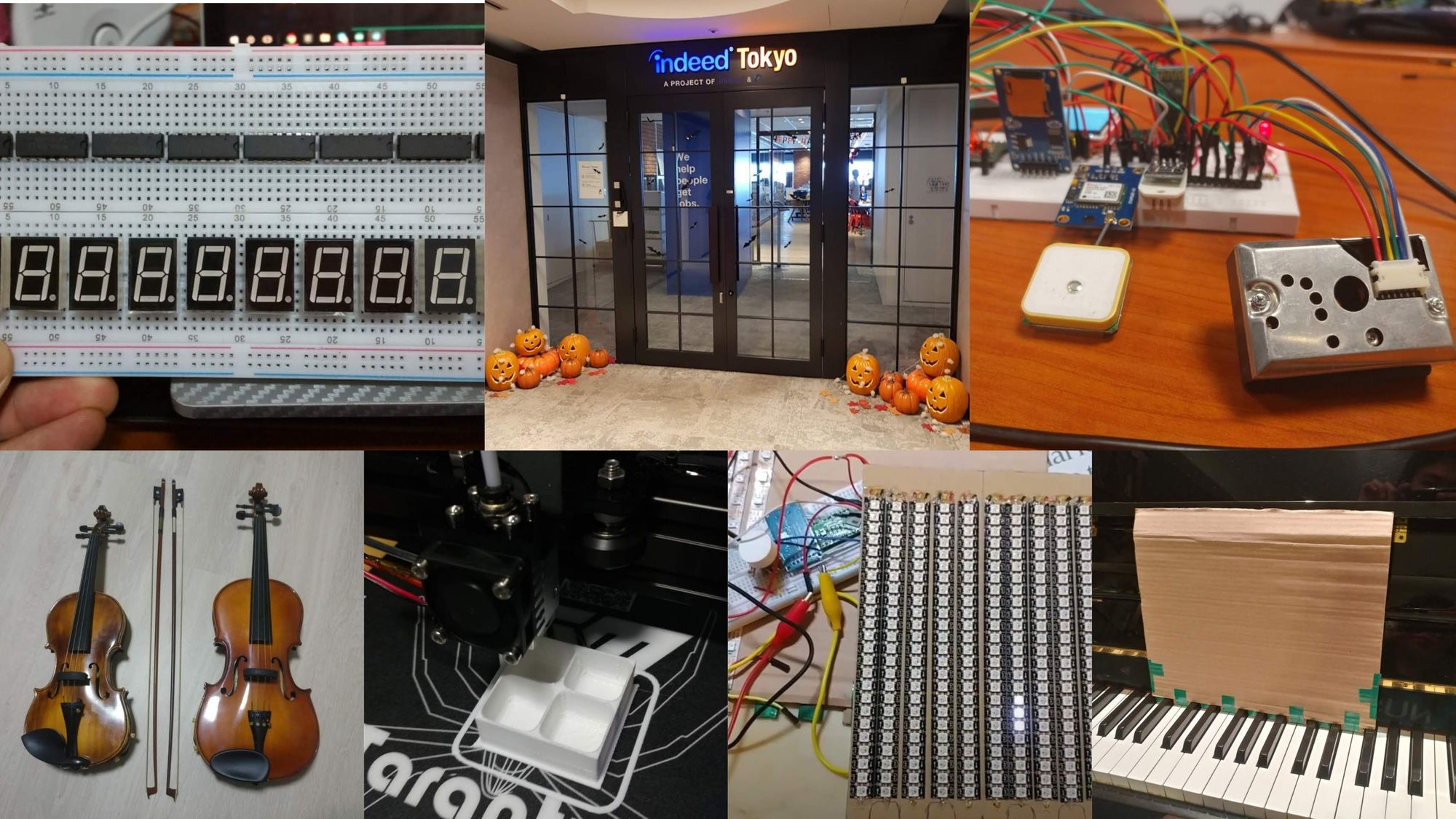
2018 (26 years old)
back to section top- Teaching Assistant
- Started Career
- Dance Performance
- Chinese Toastmasters
- First VR Headset
- Accountability with friend
- Piano Youtube Channel
Before I started work, I worked as a teaching assistant for a master's level module. It helped boost my ego even though I barely knew what I was doing. Luckily, I migrated before anyone had a chance to realise that I was a fraud.
This was the year I was dreading for a while. Throughout my childhood, I had been raised with the notion that once you start work, it'll be an endless grind and before you know it, you'd be retired wondering where your life went. This mindset made me determined to work on myself outside of my career so that I would have something else to my name besides work. I do also owe it to Zeus for being such an excellent place to work with a focus on having a good work-life balance.
At the start of the year, I moved to the US and wanted to find friends outside of work. To achieve this, I started attending all sorts of various meetups and events. This was when I started attending Chinese Toastmasters because I figured why not improve my public speaking as well as my Chinese. I also went to Japanese language meetups in hopes of improving my Japanese. It wasn't that useful since the people changed every week so I was always stuck reintroducing myself. I also didn't make that many friends from that since the people changed weekly. I joined a hip hop dance performance which allowed me to make a bunch of friends because I got to see them every week.
At home, I got my first VR headset, which allowed exercise with VR. I also wanted to get good at playing the piano, so I set up an accountability thing with my friend to release a piano cover every month. This was the start of my attempts to optimise my productivity, and it worked well for a year or so. The endeavour improved my piano and musicality tremendously, but I was still unable to play a piece fully without editing my video.
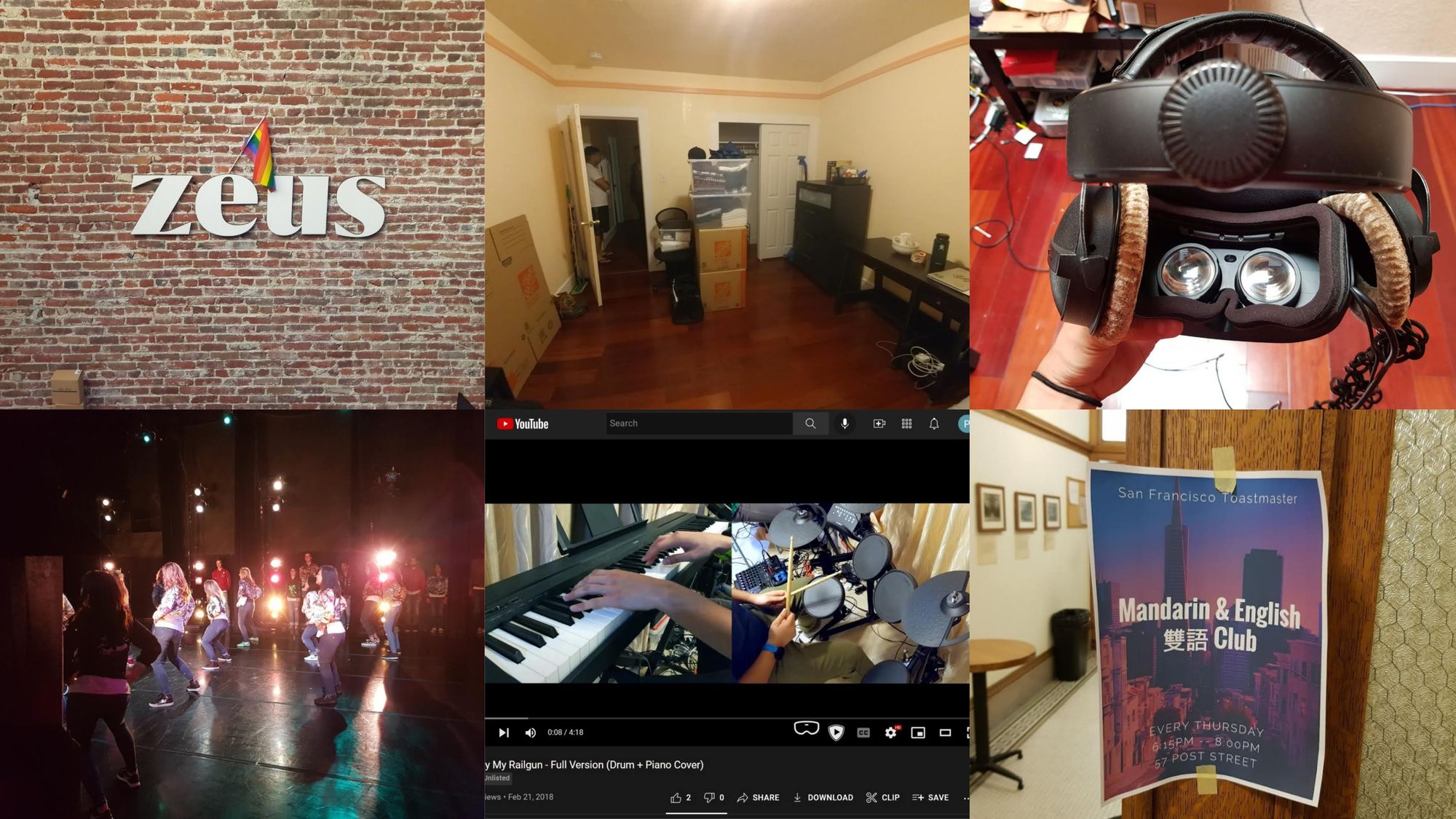
2019 (27 years old)
back to section top- Moved places
- First-ever trip for Grandparents (Spring)
- Beat Saber Mapping
- End of Youtube Channel (May)
- Topographical Maps
- VR Gym
- Defcon 2
- Lifeclocc
- Japanese Cultural Immersion
I spent the first half of this year continuing the routine I had set for myself from the previous year. One of the biggest changes is that I moved out to a nice place with a much friendlier roommate. I then spent the first bit of the year getting into a new routine and making my house all nice. Then I brought my grandparents for their first-ever holiday sponsored by not my parents. They loved it and have been talking about it ever since.
Around this time, I got into making maps for Beat Saber. Custom mapping songs were cool, but then it was cut short by lawyers removing all my maps due to copyright issues. This, in turn, got my YouTube channel unreasonably banned despite not actually reaching the three strikes required for a channel banning. This was the same channel that I posted all my piano covers over the past year, effectively making me lose a large portion of my work (I lost the computer with my backups). This put an untimely end to any motivation I had for music for a while. This, along with a couple of other things, sent me into quite a bad depression for about one month.
When I eventually got over it, I started working on other hobbies. I found a VR Gym (see Exercise Section), which was an awesome way to get exercise, and worked on some 3D printed topological maps, which I considered selling (see Notable Failures), but it turned out to be too much effort to do so.
I went to Defcon in August and had an amazing time (detailed in this blog post) and was inspired to work on Lifeclocc again. I worked on this for the rest of the year and managed to make it ready in time for Kickstarter's 2020 Make100 campaign.
Near the end of the year, I went to Japan to attend an actual Japanese Language school for a week to get a taste of it. I had planned on going back the following year to do a two-month study program to improve my Japanese; then covid happened, so my motivation to study Japanese dwindled.
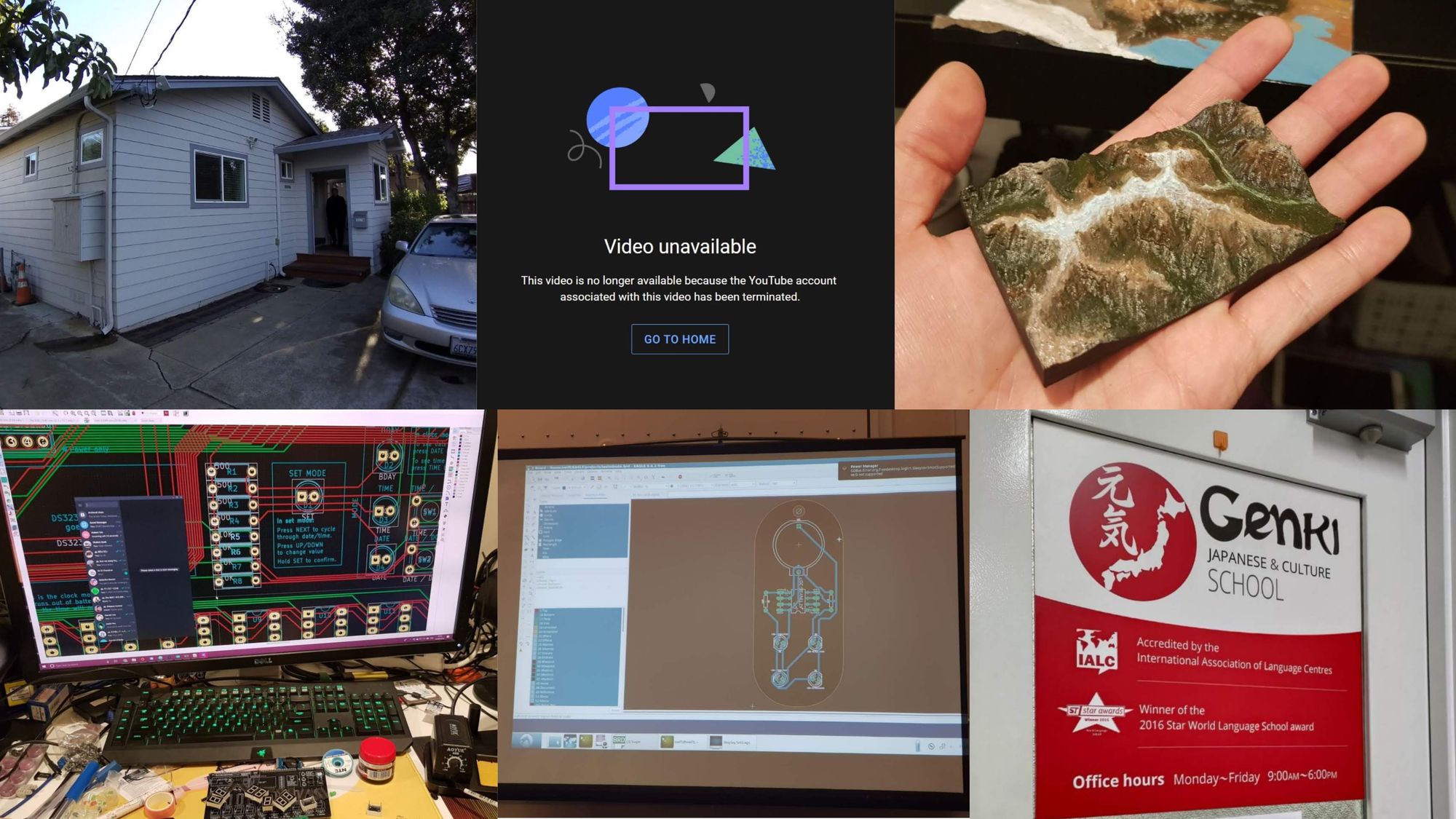
2020 (28 years old)
back to section top- Lifeclocc Kickstarter
- Keyboard
- Chibi Drawings
- DDR
- Game Studio
- Garden
- Forklift, Blacksmithing, Leatherworking
- No Zero Days
- Japanese Toastmasters
- Started playing with lasers
The pandemic caused a lot of changes in all our routines. At the start of the year, I spent a lot more time at home and needed to find new things to do and ways to exercise. Work became fully remote, as did all my social interactions. One bright side of the pandemic is that since I started working from home, I was able to work on my Kickstarter project a lot more efficiently. It required a lot of 3D printing, which could be set to run while I worked.
My friends also decided to buy me a split keyboard, which sent me down a rabbit hole of custom keyboards. I planned on writing up a post about this, but I've obviously not gotten around to it.
At some point, I decided to pick up digital drawing as well. I hadn't drawn for years, and I had no real wish to learn to draw proper anatomy, so I chose to start with a chibi anime style. This allowed me to draw things that I considered good enough for social media but didn't require much skill. I also made a nice custom keyboard with shortcuts for drawing.
I discovered that DDR still had a pretty active community around it and got into it. Turns out it's a great mode of exercise at home if you get a nice DDR pad.
Midway through the year, I decided to head back to Singapore, where the pandemic was being handled much better at that time. The government provided credits to all citizens to let them upskill, and I was happy to make use of this opportunity to learn things I wouldn't otherwise have. With that, I got a forklift license and attended a blacksmithing class where I created a knife and a small leather working workshop when I got to work with leather for the first time.
It was also around this time that I started a new accountability method called No Zero Days, which I'll elaborate on in the Motivation section.
I tried to set up an Etsy store with a laser engraver that I bought. It did not work out very well since laser cut stuff was way too common, and anyone who wanted to could easily set up a small business selling these things. Since I was not in the market for selling these items, I didn’t have the time nor drive to make nice listings and try and do marketing.
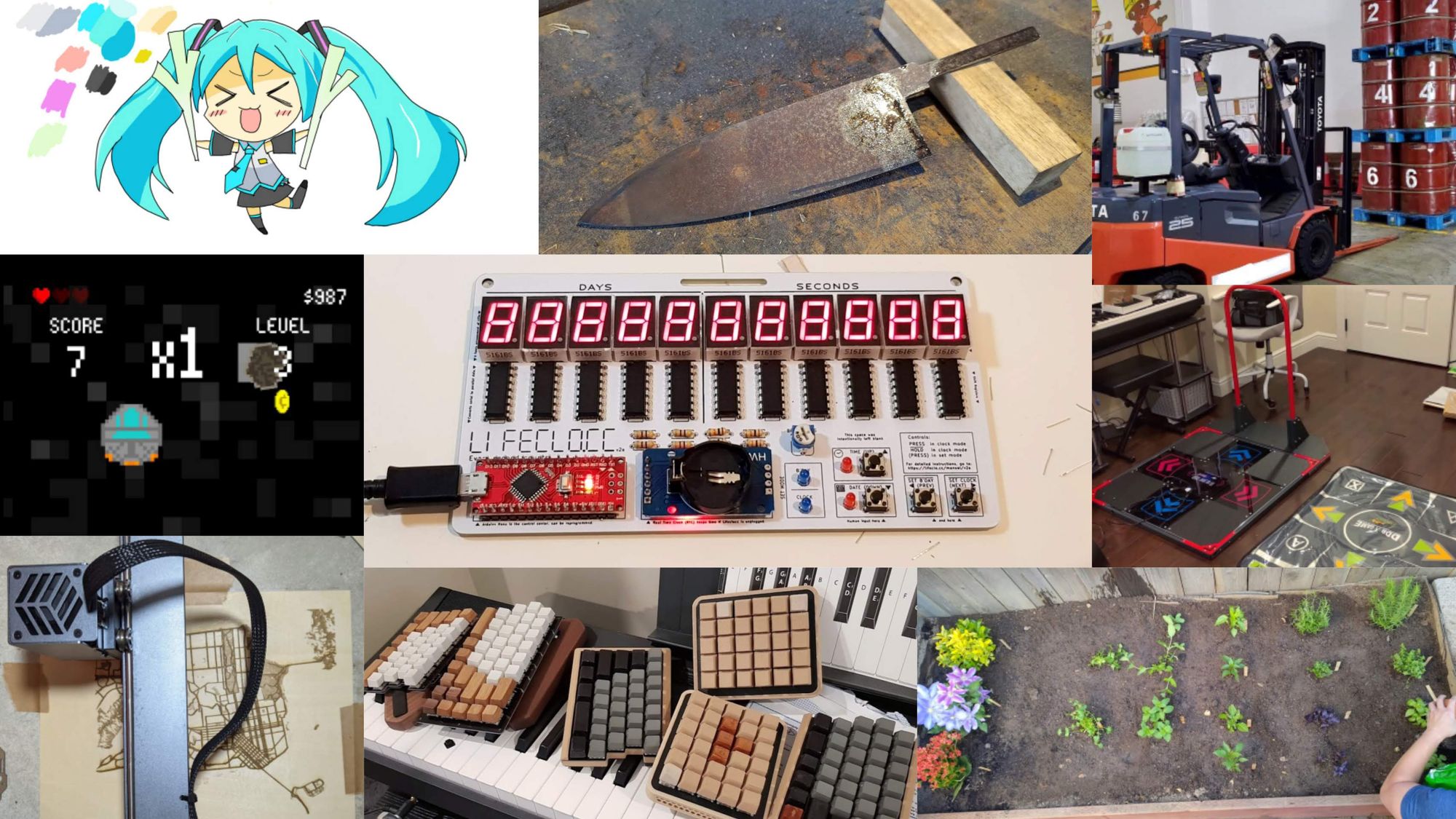
2021 (29 years old)
back to section top- Music Creation
- Custom Designed Keyboards
- Vocaloid
- Candle Making
- Trying Indiegogo
- Second Kickstarter: MetroM
- Facebook Ads
- Chinese Lessons
I started the new year by completing a course on Monthly (now rebranded as Studio) on how to make digital music. Why was I even learning to play the piano when I could get the computer to do it for me? It was also a lot more fun than grinding at the piano, trying to get my fingers to do the thing I wanted them to do when I could just tell the computer to do it.
One problem was that I didn't have a small convenient midi controller, but I used my newfound keyboard skills to design and make one from scratch. It was easier, cheaper and quicker than buying a midi controller online.
The music-making hobby held my attention for about half a year, during which I composed various pieces of music. In the middle of the year, my friend bought me the Vocaloid program Hatsune Miku, allowing me to write songs with vocals. I have a SoundCloud with a few pieces that I composed, but I've since stopped doing that since I started working on my crowdfunding projects.
I tried to port my Lifeclocc campaign to Indiegogo to test it out. They have a nice feature that would take your previous funding amount and port it over to Indiegogo. I barely got any orders on it though, after going through the trouble of migrating it. All I learned was that Indiegogo does not have as much organic traffic as Kickstarter and that I'd have to run ads.
I spent most of the rest of the year working on my MetroM Kickstarter campaign. I've talked about this at length before, so I'm not going to elaborate much here. This was the first time I tried various online advertising platforms, and I'm not sure that they really worked. I saw that I got no conversions from the ads from my analytics. But it could just be that Kickstarter’s analytics are bad.
This was also the year I finally decided to start taking Chinese lessons as well. I did this mostly because my Japanese was beginning to feel better than my Chinese, and I felt like I didn’t want to waste all that childhood trauma. I've always sucked at it because being forced to do it in school is definitely the wrong way to learn. It only took me 13 years to get over the trauma and gain some interest in it again.
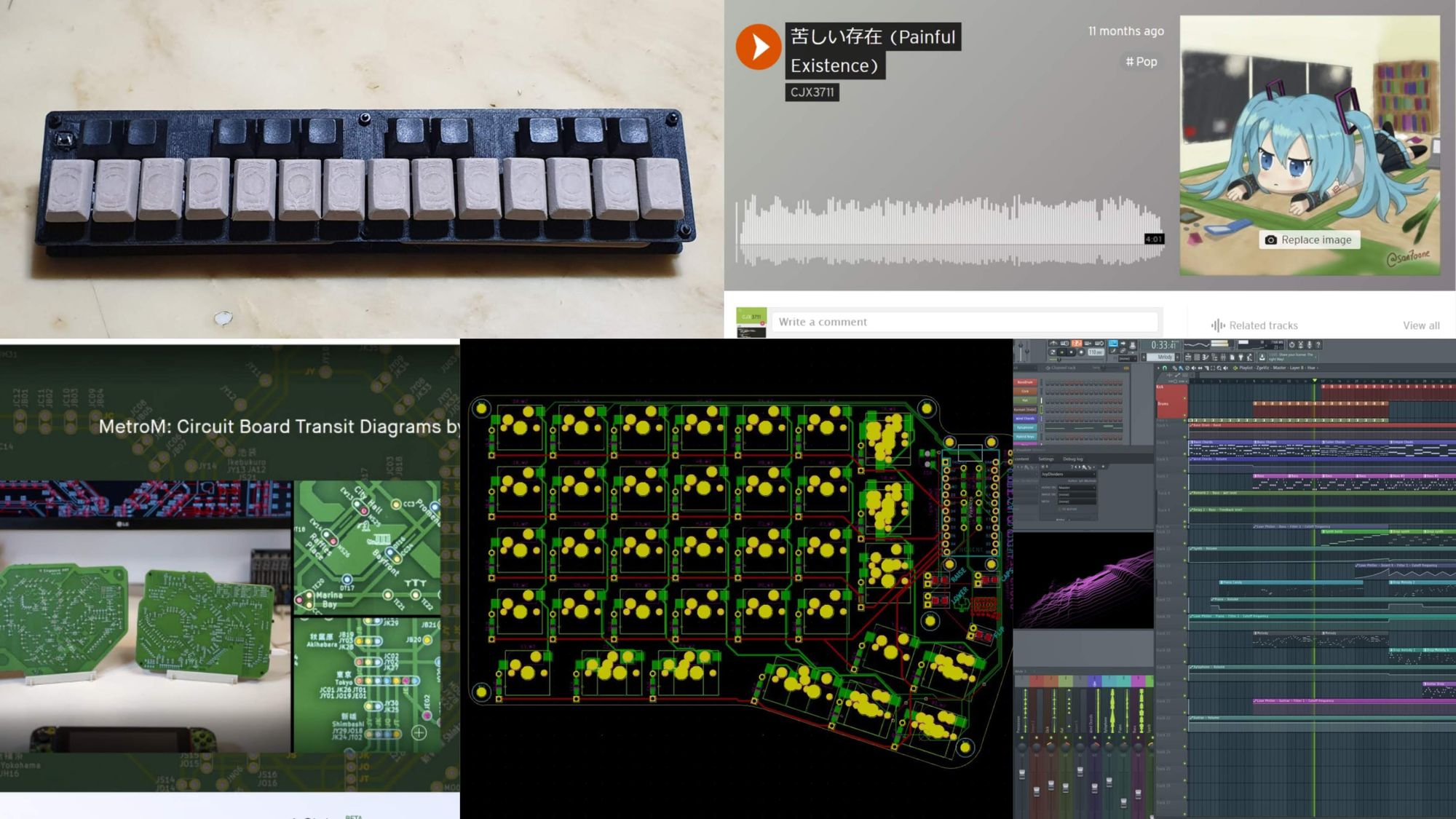
2022 (30 years old)
back to section top- Onewheel
- Drone Racing
- Cute 3D models
- Social Media
- Third Kickstarter
- More makery stuff
This bit is only half a year, but because of the weight of feeling like I haven't achieved enough, I have been trying all sorts of new random things.
I started the year by getting a Onewheel, those cool electric skateboard looking things with one big wheel in the centre. I've always been enthralled by the idea of the ability to go offroad with an electric vehicle, and this had the best chance of being that device. It took me about two weeks to get good at it, but it has been my preferred mode of transport to downtown and running errands since. It's a pity that it's now banned in Singapore, but I think it's the most optimised transportation method ever.
This was also when I decided to finally pick up FPV drone racing. I had been droning for so many years till now, but it's one thing to try and get a nice cinematic shot with all the stabilisation and GPS assistance, and it's another to blaze through small nooks and crannies at 100km/h. I had to start with a simulator, but even so, you can get quite an adrenaline rush from it.
At this point, I had also given up my avoidance of Tiktok and decided to join the foray. I started posting more on Instagram Stories and Tiktok. I figure that I might want to be a maker-influencer at some point, and I have to start somewhere. Not that I've been putting in enough effort to have any real following.
I launched another Kickstarter shortly before my birthday because I wanted 3 Kickstarter campaigns by 30. There was no good reason for this.
Other random things I did:
I started sewing things, bought a crochet kit, bought an embroidery kit, learnt a bit of glass blowing, and did a bit of metalworking.

When I was writing this, I expected to have more notable events in recent years than in the earlier part of the decade due to the recency effect. Fortunately, because I have pictures dating back ten years, it was quite easy to track what I've been doing all that time. Looking back at all the cool and interesting things that have happened throughout the years, I realise that, if anything, I've had fewer new experiences as of late. To be fair, this is probably because I've managed to get my shit together and actually focus on projects and see them through as opposed to trying to do 100 things at once.
Tracking My Life
back to topI've posted before about how I've been tracking my expenses for more than ten years. Still, I love data visualisations and have attempted to track a lot more things than just my expenses. Here is the list of things that I have kept track of and how successful I've been.
- Finances
- Time
- Location
- Weight
- Physical Activities
- Heart Rate
- Fuel
- Sleep
- Food
- Productivity
- Electricity Usage
- Photos
- Tech
Finances
back to section top13 years of data - very manual process – I wrote a post about this
I have tracked all my expenses since 2009 or so. Some of this data was in a windows phone app in a different data format, but most of it is in Toshl. I won’t go into detail again about how I track my expenses, so here’s an interesting analysis.
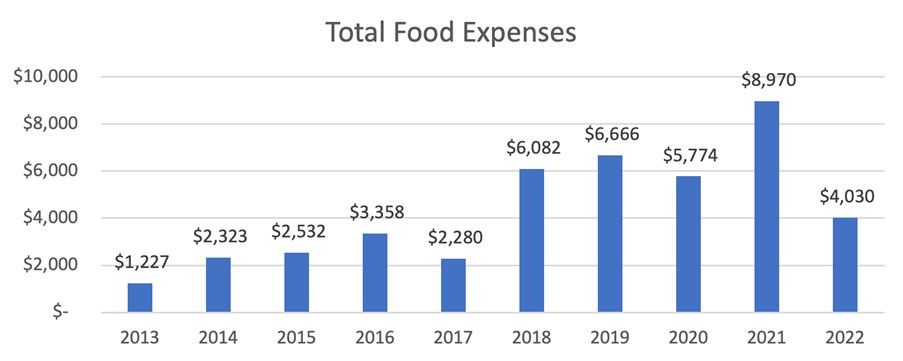
This is the amount of money I’ve spent in total on food. It includes everything I consume, be it eating out, or buying groceries.
In 2013, I spent the entire year in the army, where food was provided, so I barely spent anything. No surprises there. From 2014 onwards, I had to buy about one meal a day since I went to school. In 2016, I had an internship in the US. Food is more expensive in California, but lunch was provided at the office, so I still only had to pay for one meal a day. Since we were poor uni kids, we cooked a lot at home, but the cost was still higher than eating out daily in Singapore.
In 2018, I moved to the US for work, and I no longer needed to limit eating out to special occasions. One meal a day was still provided at work, yet my expenses tripled. US$5 can get you a decent meal in Singapore, while a similar meal in the valley would be $15-20 after tips. From 2020 onwards, I no longer went to the office because covid, but since we also couldn’t go out, my food costs decreased by quite a bit.
Food expenses increased by quite a bit in 2021. My best guess would be that it’s a combination of the increase in food prices and that I started going out more often after being stuck at home for a year. The 2022 bar is only half a year’s worth of expenses and looks like it’ll trend towards the 2021 levels.

But who cares about food? Here’s a graph of my bubble tea spending (or boba, as the Americans call it). I only started tracking this in 2016, but you can see that the average cost of a cup in the US was $5.23, while a cup in Singapore was $3.19 in 2016 and 2017, respectively. After I went back to the US in 2018, the price of a cup stayed quite consistent until 2021, before the prices shot up by 40%. Covid + the war + supply chain issues can even be seen in my bubble tea chart.
I’ve been averaging about 50+ cups a year for the past few years; this is slightly more than one cup a week. This is starting to feel like a problem, but I’ll leave it to be future me to deal with that.
Time
back to section topMostly manual – The app I use is somewhat automated, but I need to clean it up daily.
I started time tracking in uni because I noticed that I was spending a lot more time on one of the modules than the recommended amount and neglecting the other modules. I went through a long process of testing all sorts of time tracking apps, but they all required too much manual entry and are usually geared towards tracking billable hours and not your entire life. That is until I found Smarter Time. It was the perfect balance of automated and manual tracking.
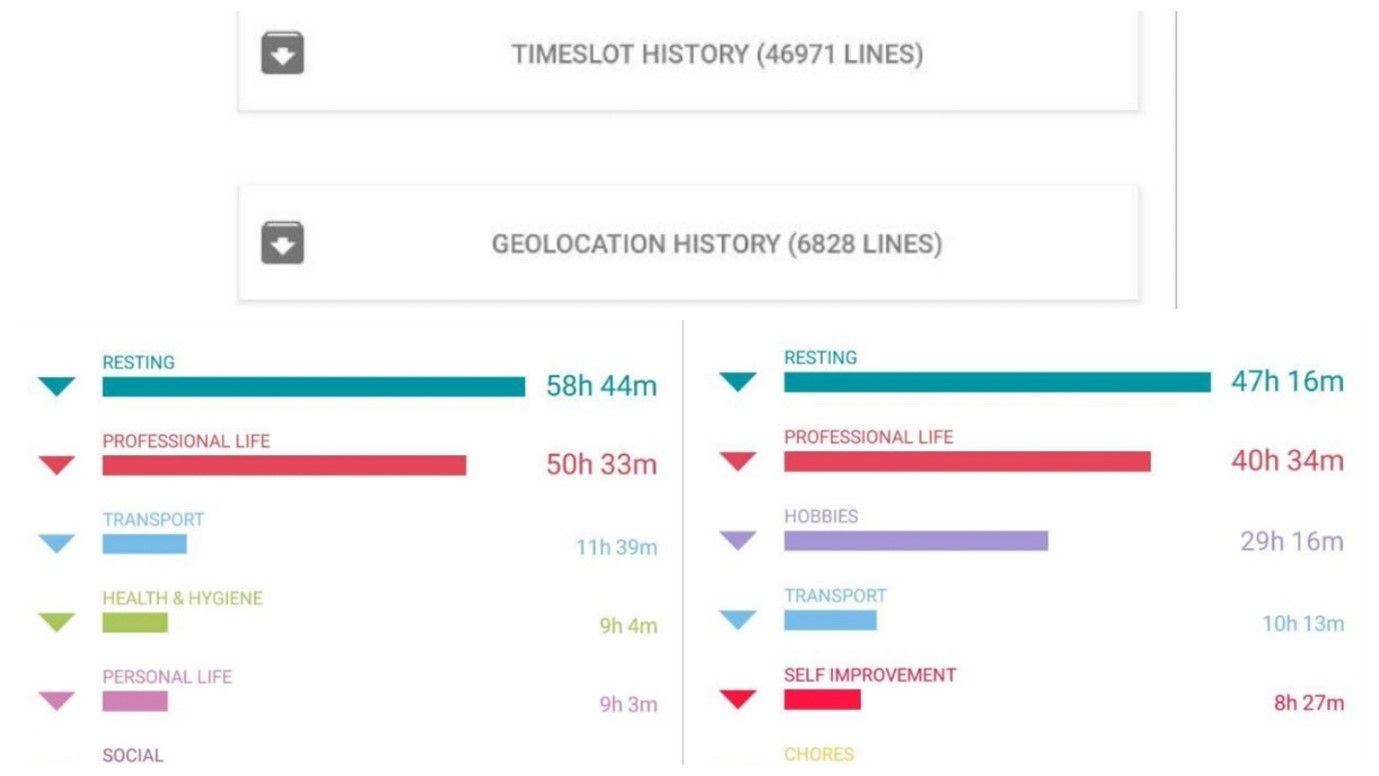
Despite flaws in the tracking, and the inability to keep my tracking on the cloud, it has been my tracking app for the past seven years. Unfortunately, the devs have seemingly abandoned the project, and it's only a matter of time before this app gets outdated, and I will be left looking for a new tracking app. At that point, I might just decide to make my own.
Location
back to section topFully automated – Google likes to stalk me
I've looked at my location history, and the earliest data dates back to 2013. This is mostly thanks to enabling the Location History feature on Google Maps. I don't even remember turning on the feature, but I guess that's when Google decided to release this feature. I am kind of sad that this didn't happen sooner since I would like to see data from all the way back in my teenage life.

Those maps aren’t very informative, so here’s a visualisation that should work better that covers my entire life, not just since 2013. It is based on my terrible memory and asking my parents for dates from before the Google times. Sizes are log scaled to make the visualisation functional.
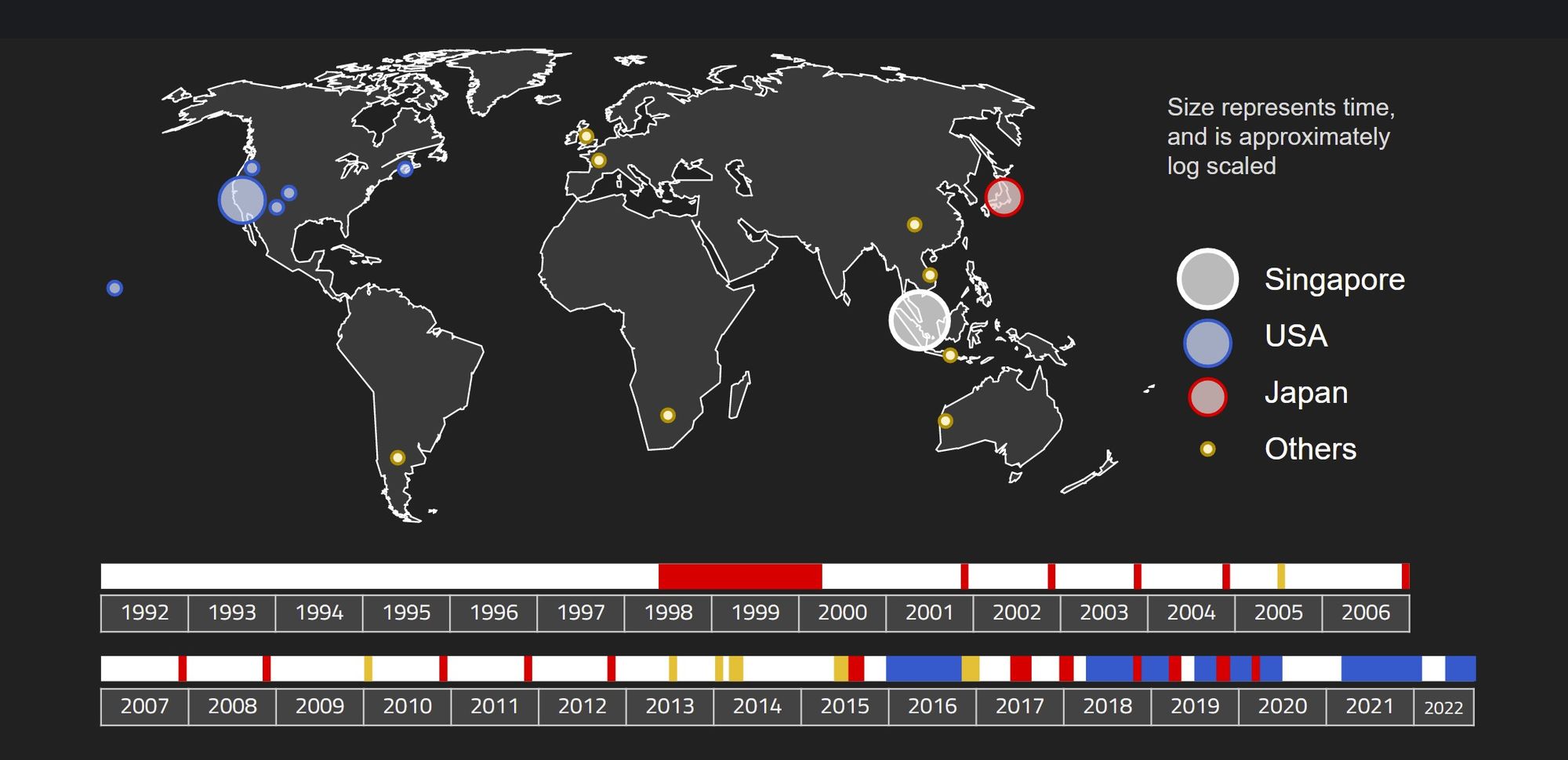
Weight
back to section topPartially automated – I have a scale that auto uploads the weight
I have my weight history stored in Google since 2014. At that time, it was mostly manual entry, and I only weighed myself once every few weeks. But in 2020, I bought a Garmin scale that automatically uploaded the weight without me needing to key in any data. All I had to do was to stand on it every day. I also managed to get Garmin to sync to Google Fit so the data continues to be in the same place.

Weight tracking doesn’t do much, but it’s funny to see my weight go up when I go to countries with good food and go down when I go back to the US.
Physical Activities
back to section topManual – I need to start the activity each time
Before I had a GPS watch that could track my runs and heart rate, I tracked all of my exercises with my phone on Endomondo. I started tracking my longer walks as well as my runs sometime during my military stint. Prior to that, I don’t think I exercised much. Tracking my workouts became one of the main reasons I even worked out. If I didn't have my tracking on, I would have no motivation to exercise at all.
Unfortunately, Endomondo shut down, and I had to import all my data into MapMyRun (which I dislike a lot more). Here's a map of my hike in South Africa, originally tracked with Endomondo, now displayed in MapMyRun.
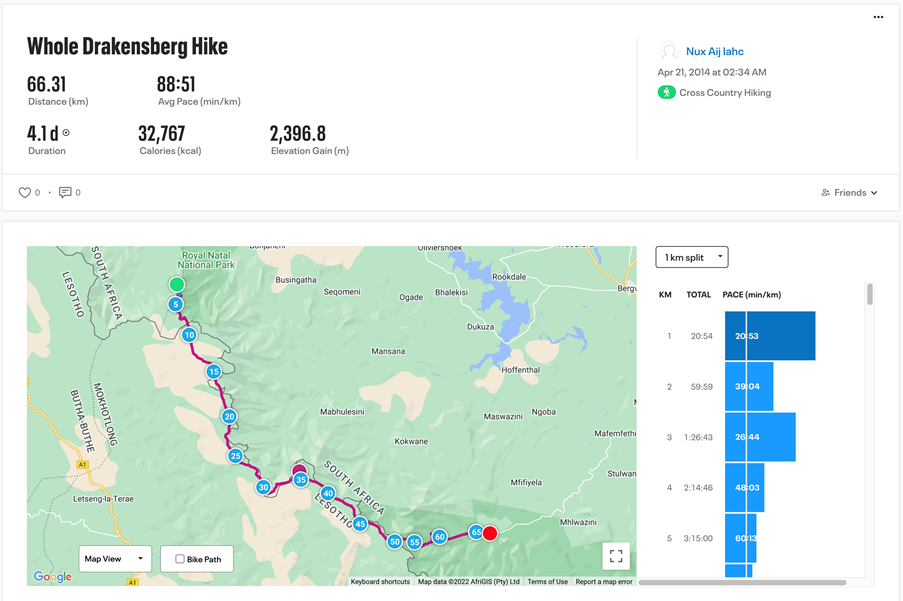
Once I got my Garmin watch, my workouts also tracked my heart rate, which I assume gives me a much better estimate of the calories I burn.
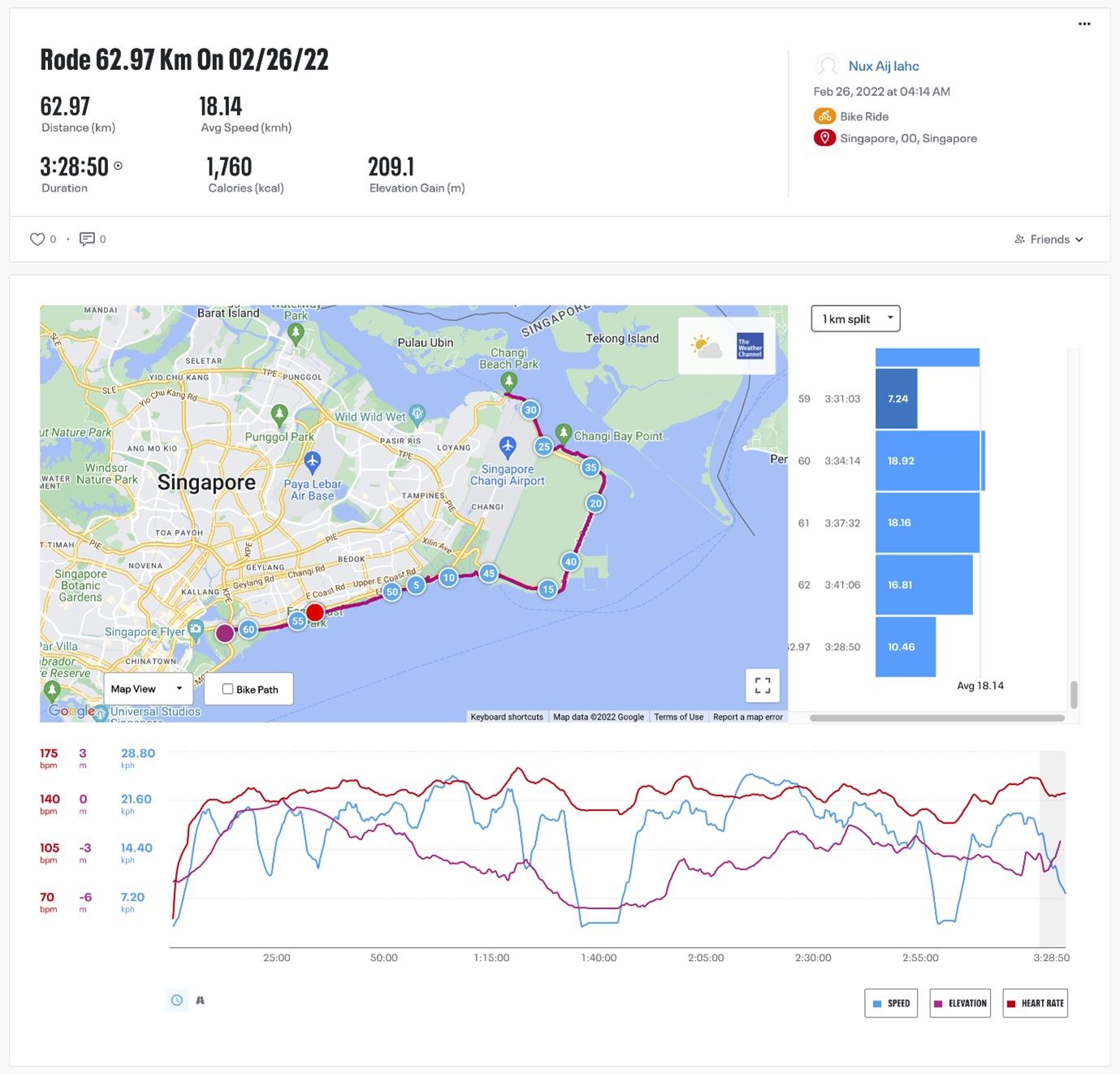
Heart Rate
back to section topFully Automated – The watch is always on my wrist
The first watch that could track my heart rate was a pebble (which I loved dearly till Fitbit killed them). I joined the Garmin ecosystem in 2017, and that’s the start of my historical heart rate data. I don't think I saved the heart rate data from the days of the pebble, so I only have the data from 2018 to work with. I haven't run any meaningful stats on this yet, but I figure that one day I will be able to plot a graph of my resting heart rate over time to gauge my fitness level.
Since I do have historical HR data, I can pull exciting things like this:

Fuel
back to section topFully Manual – in a google sheet
When I got my first car, I wanted to keep track of the fuel economy and everything related to the car's fuel usage. This was a manual process that I had no way of automating. I took pictures of the odometer and the petrol receipt each time I had to top up. This allowed me to key it into the spreadsheet when I got home, and I could run the numbers.
I gained nothing from this except the ability to make some graphs of fuel prices and the fuel economy of my car.

I still keep track of my fuel to this day. My new car also has built-in MPG calculations, and it's interesting to see how the internal calculations match up to the ones I have on my spreadsheet. They're mostly correct)
Sleep
back to section topFully automated – My watch keeps track of it
I have been using an app called Sleep By Android to track my sleep. It was both my sleep tracker as well as my alarm app. Back in the day, I would have to let the app know that I was going to sleep for it to start the tracking. It would then track my sleep and let me know how much time was spent in what phase of sleep. To this day, I am unsure how accurate this is, but I never really put that much thought into it.
Once I got my Garmin, I stopped having to input my sleep times manually. The watch would automatically detect when I go to bed and also track the different sleep cycles. This seemingly worked, but the watch would often attribute my hitting snooze to having woken up.
This sleep data started getting even messier when I attempted polyphasic and nocturnal sleep cycles. It does not understand that people can take naps during the day and does not track those as sleep time. Also, when I sleep from 7 am to 12 pm, the watch does not track it properly since it wasn't programmed for people to start their sleep in the mornings.
This doesn't really matter to me since I manually key in my sleep time into the time tracking app anyway, but I guess I won't really have good data to analyse how much deep and light sleep I'm getting.
Food
back to section topFully manual, defunct
At one point in my failed weight loss journey (see section on Notable Failures > Being Fit), I wanted to track my food intake as well as my exercise. I tried doing it in 2 ways; the first one was downloading an app that supposedly tracks the calorie intake of your food. The problem is that because it was fully manual and American centric, a lot of the food I ate was not on their list. In the end, I would be guesstimating the number of calories I'd be eating anyway.
After that, I decided to make it much easier for myself. I started tracking my food on a scale of 1-5 in a spreadsheet. This allowed me to see how much I was eating over the course of the day, but it was mostly graded on how I felt after each meal. I think this was quite a good method of tracking my food, but I had no noticeable weight loss even after trying out this new mindful eating method. As you can see, I lost interest in this even before a year was up.
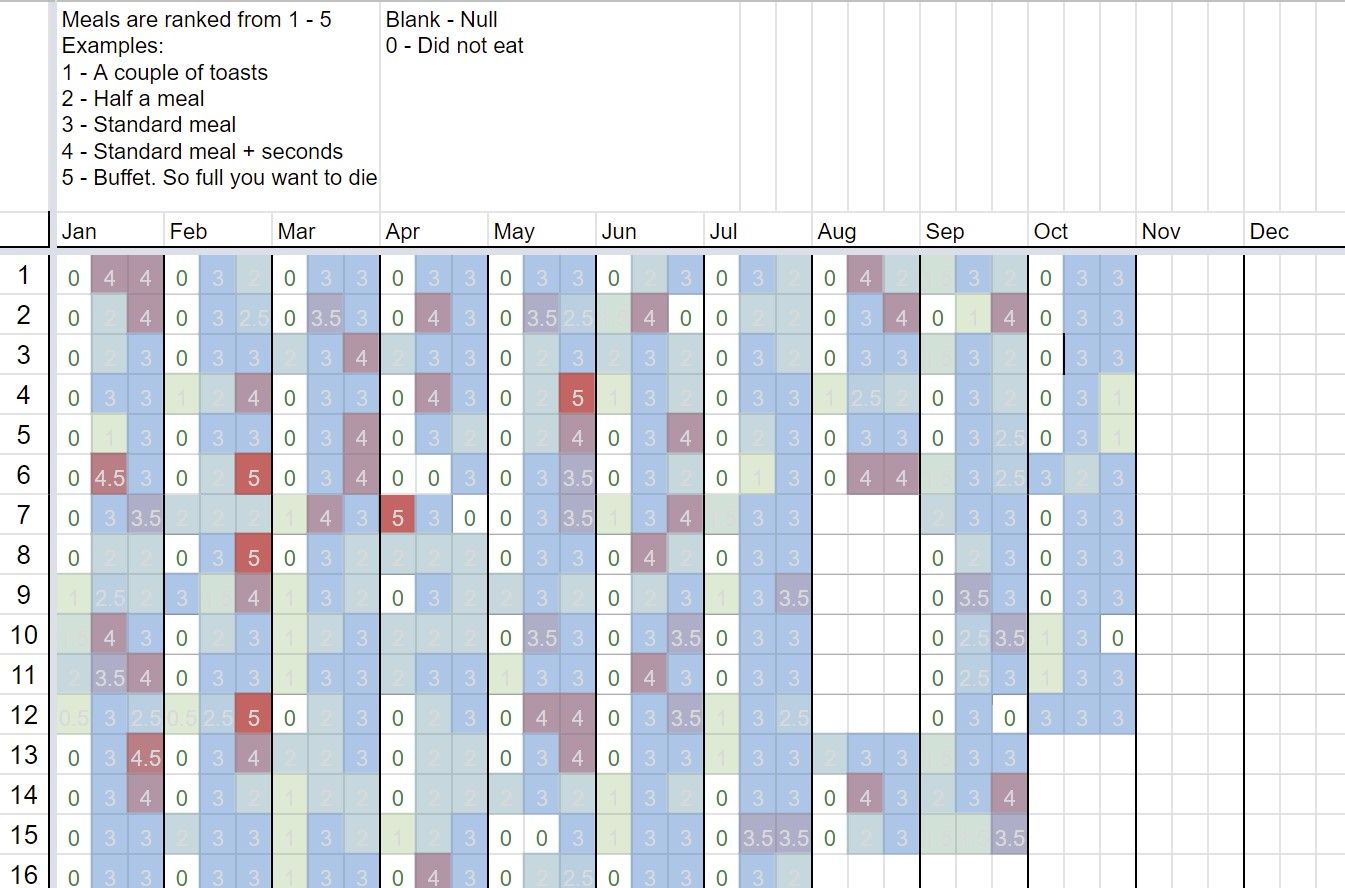
Productivity
back to section topFully manual, inconsistent and defunct
I tracked the productive things I did daily in a google spreadsheet and managed to keep it going for about two years.
The idea was inspired by a speech I heard, which was in turn inspired by the book Atomic Habits if I remember correctly. The concept was called No Zero Days or small habits. The idea is that if you want to build a habit, you need to make sure you work on the task every single day without fail.
For example, if you want to learn to draw, the goal should be to pick up a pencil and draw even just one stroke.
By forcing yourself to do this, you will not really have a good excuse not to do it daily since it's such a simple task. But by sitting down and starting the task, you get over the effort required to start the task, and you will likely do more than just a minute of the task anyway. Over a few weeks, when you look back at what you’ve done, you’ll be surprised by how much you’ve managed to achieve.
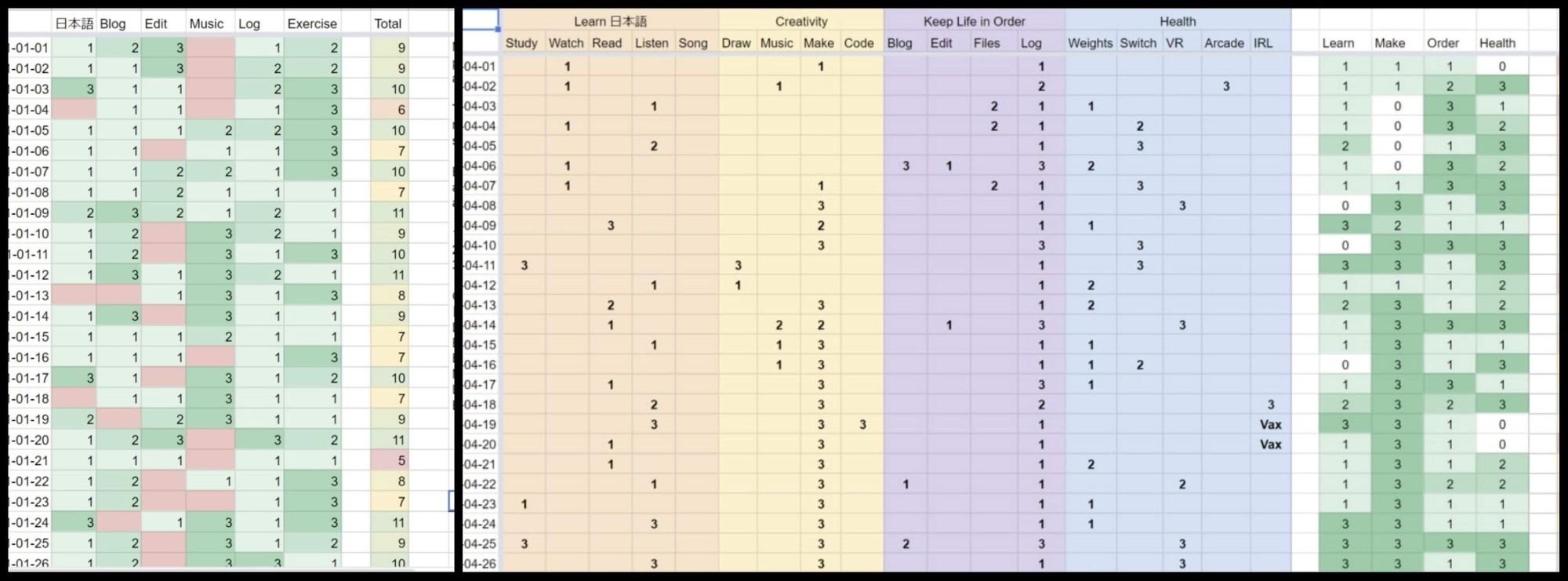
I really liked the idea and wanted to adapt it for my numerous hobbies, so I split it into various categories. After a year or so, I updated the categories and added even more columns. This worked out well for a while, but I eventually stopped doing it because it became overwhelming. I guess it diverged too much from the spirit of the small habits.
It has been the best method I've had for keeping my life in check. The Google Sheet method isn't the best, though, and I've been thinking about making my own app instead. While it's currently defunct, I will likely start on another version of this again.
Electricity Usage
back to section topAutomated but limited
There is nothing fancy here; I have a smart plug that gives me a day-to-day electricity breakdown of the things plugged into it. Most of my household appliances are plugged into these smart plugs. This allows me to easily see how much energy I am using at any point and look up the historical energy usage.
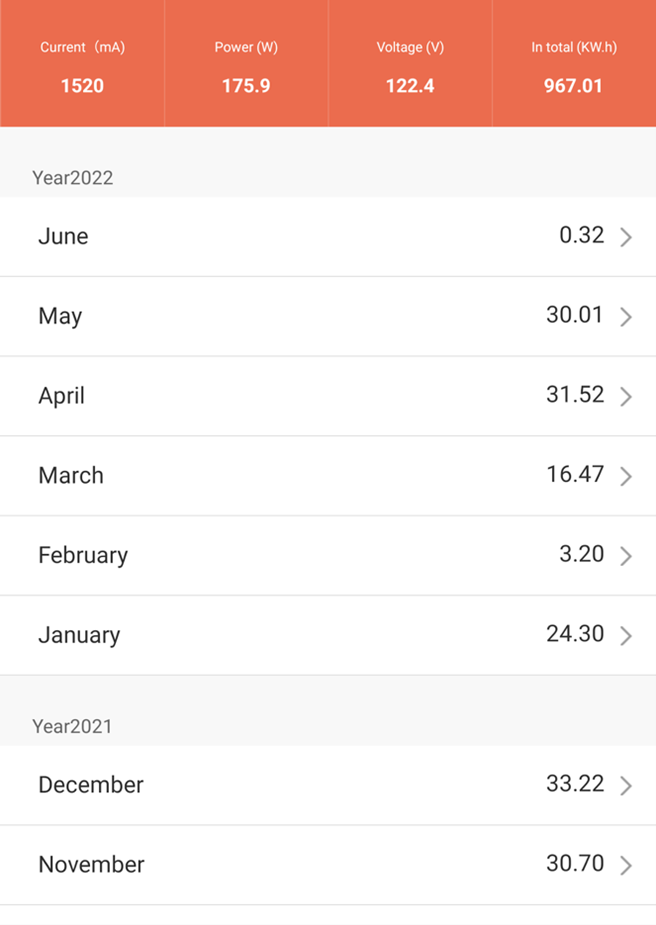
This is a screenshot from the app with the setup I'm using to type this post now, one MacBook and a screen, which takes up 175W of power to run.
The app doesn't allow scrolling, probably due to a bug, so I only get to see the past few months of data.
Since 2019, I've used almost 1000kWh of energy for my computer alone. With California's electricity cost of about 20c/kWh, that comes to just about $200 that I've spent to run this computer over the past three years.
Sidenote: It's easy to see that I was in Singapore in February and March from my electricity usage alone.
I mostly used this for figuring out how much electricity all my 3D printing and laser cutting took up. Unfortunately, the app is propriety, and I could not export the data for any form of analysis. If the device breaks, I have no way to retrieve the data. I still haven't found a smart plug that would allow me to export the electricity usage data either.
Photos
back to section topKind of Automatic – I still have to take the photos.
Not strictly tracking but having all my photos in one place has been one of the most useful things I've ever done in my life. I use Google Photos for automated backups, and it's been such an essential tool in my daily life that I've started paying for Google's subscription. I even wrote a post before about Google Photos and how amazing it was, with emphasis on was. (I am still upset that they removed unlimited free storage, but who am I kidding, that was bound to happen at some point).
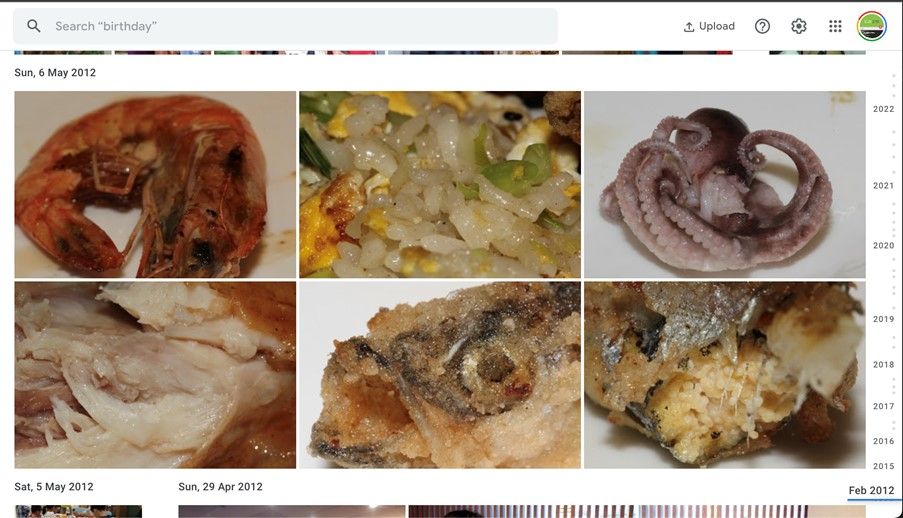
My use cases for Google Photos:
- Figuring out my expense tracking (by seeing pics of what I bought or ate that day)
- Figuring out what I did on a particular day
- Finding out when the last time I visited a place was
- Figuring out what I saw at a certain location
- Searching for signs and text in photos
- Looking for photos or videos of people
- Go through my history to jog my memory of notable events (see section on Notable Events)
A lot of these depend on the fact that the photos are location-tagged, and Google Photos does a really good job with facial, text, and object recognition in the photos so searching through the photos is a breeze.
Essentially, Google Photos acts as a supplementary brain for me since I am terrible at remembering anything about one day later.
I would love to have a way to remove my dependence on Google Photos, but for now, this seems to be the only way to achieve what I need. I really hope Google doesn't go bust or sunset Google Photos anytime.
One interesting side note is that you can roughly see when I discovered how to use Google Photos to do all these cool things. You can see the date scroll bar on the right side in the image above. I started taking significantly more photos in 2019, almost twice in 2018. 2020 is a bit smaller since the pandemic happened, and we all barely went out, so there wasn't much to take anyway.
Tech
back to section topFully manual one-off analysis
Also not technically tracking, but I went back through my photos' metadata and memory and roughly figured out what devices I've used over the years. I originally did this for a work presentation, but I figured that this was too good a visualisation not to include in this post.
For the more recent phones, I took the dates of the first and last photos taken with those devices to get the rough usage dates. It was mostly from memory and cross-referencing against their release dates for older devices to make sure I didn't get it too wrong. One caveat is that I only have my handheld devices tracked since it was pretty hard for me to get the computers and laptops I've used over the years.
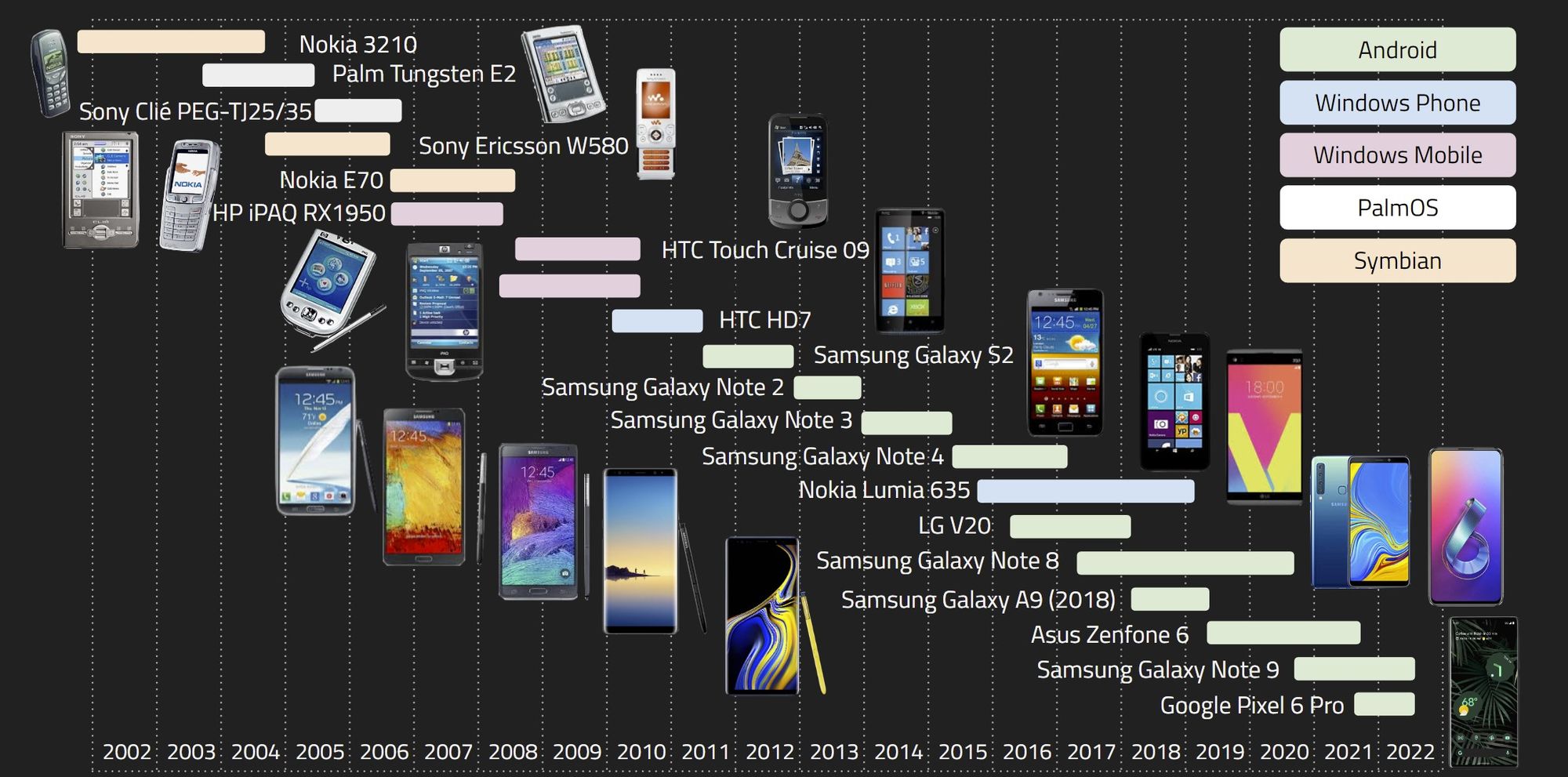
As you can see, sometime around 2015, I started using two phones at once. I have another blog post planned about the virtues of having two phones, but that's still in my eternal backlog of blog posts to write.
And that’s all the things that I currently and have historically tracked. There are still people out there who are way better than me at tracking things, but I'm pretty happy with the setup I currently have, as flawed as it is.
My Relationship with Motivation
back to topThe motivation I am referring to here is the motivation to complete the things that I have set out to do. I am not talking about what motivates me in life. I still have not figured that out, and if anyone has any good ideas, please let me know.
Bouncing from project to project
In my early 20s, I rarely finished anything I set out to achieve outside of work or school. I would have a bout of interest in a topic and go all in on it, with my entire life revolving around this topic for a few days or sometimes weeks. But once I lost interest in it, there was little chance it would ever be completed.
This applied to learning things outside of my schoolwork or finishing projects that I picked up. In the Notable Failures section, you'll see all the things that I’ve tried to do and given up on. That's not to say that I achieved nothing when I was younger. It's just that if I didn't manage to maintain an interest in a topic for long enough, the thing would be left aside and probably never touched again. This would usually be the case as well since I would have a constant stream of new things that I found interesting and wanted to try doing. I'm not saying that this is unique to me, and I've seen many a meme talking about old projects left unfinished. When I was about 25, I wouldn’t have had any big project that I would be proud to call mine. All I had were projects that were perpetually “in the works.”
Of course, it’s not like I had much of a choice when it came to schoolwork because I would be forced to study. But even then, as a kid, I do not recall ever doing my homework willingly. In the army, I wouldn't have a problem waking up at a given time or going to exercise because I was mostly driven by fear. That said, it felt like I was always extremely busy since I would be juggling 2 or 3 projects alongside my studies or service. Despite that, I never completed any of the projects to a satisfactory level since I would typically hit a big roadblock of sorts, and then something else more interesting would pull me away.
Being guided by external forces
Based on what I said above, one would wonder how I managed to complete anything at all. If you look at my (very outdated) portfolio, it’s not like it’s the barren wasteland I make it out to be. Most of what I achieved during this time, I owe it to other people in my life.
From my late teens, I worked with my cousin on a small creative agency where we made websites and videos for people. He was the one who looked for business opportunities and told me what needed to be done, and I would then figure out how to implement it. This benefitted me greatly, even though I was pretty salty about always having work dumped on me. I wouldn’t otherwise have had the drive to learn things well by myself anyway, and this was an excellent platform for me to pick up a myriad of skills.
He was also quite optimistic (or just a lying brat) too, promising clients that a website or video would be done knowing full well that neither of us had the skills to do it. The pressure of having a paying client was a very good motivator to learn how to code a website or edit a video. Because of this, I learned how to code a website or an app, figure out DevOps and internet infrastructure, operate photography and videography equipment, and fly a drone.
Besides this, I also had other obvious external motivators, like exams and not wanting to fail school.
Becoming aware of this problem
I'm not sure when I started realising this was a problem, but I think it was some time in 2016 when I did my internship/exchange in the US. Living away from my family and usual support systems allowed me the opportunity to think about what I wanted to do, and what I've achieved. I realised that almost anything I've achieved till then was because of my cousin or because someone else was involved. I hadn't really managed to achieve much by myself since anything I started never got completed.
Accountability
So obviously, I needed something to keep myself accountable. A prime example of this was when I lived alone, there was no one to drag me out of bed anymore. That meant that unless I had to go to work that day. I could simply sleep the entire weekend away if I had the opportunity. To ensure I woke up, I would schedule some sort of meeting or class to attend on the morning of the weekends. I've tried very hard to use determination and willpower to force myself to wake up at a specific time, but sleepy me is a completely different person and will hit the snooze button for an hour at least. The only thing that would wake me up would be the fear of getting in trouble or letting someone down if I missed a meeting.
Another good example would be keeping fit and exercising. Aspirationally, I would love to go for a daily workout and be fit. In reality, forcing myself to go for a run daily was not something that willpower alone would help with (with the exception being the military, but that's a special case). I have put a lot of thought into this, so I’ve dedicated an entire section below to exercise.
Since I know I get random bouts of motivation to do things, I've started using that to lock in plans that would force me to complete them so I can't back out of it. For example, whenever I start to think how nice it would be if I were fluent in Japanese, I would book an online lesson. That way, I'd be using my instantaneous motivation to get some good out of it. Unfortunately, this doesn't work for everything, in fact, it's only applicable to very specific things that would allow you to book things in advance.
The next thing I did was to get an accountability buddy to work on something together. In my case, it was that I wanted to learn to play the piano. I made a deal with a friend that I would release one piano cover a month while he would release one drawing weekly. For this, we both had to come up with an achievable goal at a regular interval. Enforcement of this was pretty ad-hoc, but the general idea was that we'd check in on each other occasionally. The guilt of not completing the task would give me the determination to sit down and play the piano for an hour each day. Ignoring the asshat lawyers who ruined my life, it worked out well for a whole year. It was also the first time that I managed to stick to anything for that long.
Building a Habit
Having an accountability buddy is great, but that would require the other person to also keep up their end of the bargain. People's lives are constantly changing and it's not healthy to have to constantly depend on people to keep my motivation (so my therapist tells me). At the very least, it's not a sustainable option, so I needed to find a way to keep something up without depending on someone else. This was when I came up with my no zero days spreadsheet. I've covered this method in detail in my Tracking section, but it has managed to keep me on track for drawing, exercising, or general skill learning for a couple of years during the pandemic. Unfortunately, doing it alone is still not very easy, so I've also roped in a friend and brother to share a spreadsheet with me and work with me on this. That way we lightly keep each other accountable by having this information shared, but we don't have to agree on anything or enforce it. (So much for not depending on others. If you don’t go for therapy, you won’t hear about your codependence)
Making a Kickstarter (taking accountability to the next level)
Even if you build habits, or learn things on a daily basis, there's nothing that forces me to complete a project. While I was happy that I was able to play the piano, or draw stuff, I never felt like I had brought a project through to completion. Also, it's hard to say when a project is complete, so I needed some way of drawing that line. For example, when I played the piano, there was a clear deadline to meet; the end of the month. Even if my piece wasn’t perfect, I would still have to release whatever I had. But when working on an app, or a cool hardware project, there would be no end to the improvements that you could make to it.
Around the start of 2020, Kickstarter was running a make100 campaign. This was to encourage small-time creators like me to create a small production batch of a product, up to 100 pieces. At the time, I had the perfect project for it, Lifeclocc. It also meant that I had a deadline to finish Lifeclocc, and I would have to stop making improvements and work on polishing the marketing material to sell it. First, I had a deadline to submit the Kickstarter project; then, I had 50 people who paid money who were waiting for my product. That provided me all the motivation I needed to finish delivering the product.
Thanks to Kickstarter, Lifeclocc was the first-ever project that I had ever seen to completion without someone else making me do it. (Ok, technically, I just stopped using friends, family, work or school as the motivator. Instead, I’m using random internet strangers, but that’s what an influencer is anyway.)
Not only did I get fulfilment from running a successful Kickstarter campaign, but it also allowed me to finally have something I could call mine. It’s all I talk about now. Speaking of which, have you seen lifeclo.cc and metrom.app?
Do you need motivation? Get yourself a lifeclo.cc, or visit app.lifeclo.cc today! You’ll never procrastinate again as you watch your life tick away right in front of your eyes!

Tricking Myself into Exercising
back to topSpeaking of motivation, exercise and being healthy are one of the hardest things anyone can achieve. Over the years, I've had to find all sorts of ways to somehow get myself to exercise. I've tried everything from guilting myself to doing it, to tricking myself into exercising without realising.
Back in the army, motivation wasn't really an issue. I mostly exercised out of necessity, and it's not like I had a say in the matter. I did, on occasion, go out to do an exercise without being forced to, but that was because there wasn't much else to do in camp (except coding surreptitiously).
When I left the army, I figured I might as well get something out of my military stint and wanted to keep up my fitness level. But it's one thing to want to be fit, but it's an entirely different thing to find the motivation or discipline to be fit.
- Tracking my exercises
- Accountability with Friends
- Zombies Run
- Arcade fitness
- VR Fitness
- Ring Fit
- DDR mat
- Just Dance (The game, but also actual dance)
- VR Gym
- Night Cycles with friends
- Mountaineering
- Trampoline
- Other Gimmicky Devices (Activ5)
Tracking my exercises
back to section topOn the basic level, exercise tracking kept me going. Tracking my run or workout made me feel better about it, even if I never looked at the track later. Just the possibility of me looking at it and judging my past self would push me to run that additional lap or run a little bit faster to get a nicer number on my calorie count. (Yes, I know these are inaccurate, but at least it was something I could use to convince myself that something was being done).
Now that my friends and I use Garmin watches, we also benefit from its social aspects, and we get to share our workouts with each other, providing some remote accountability.
Accountability with Friends
back to section topSimilar to how I have accountability buddies to do things, I also used the same method to get my ass out of bed and be active.
When I stayed in school, I would participate in weekly badminton games or go with friends to exercise. I didn't like going to exercise alone since I could easily blow it off if I didn't feel like exercising. What I did was to make plans with friends when I was feeling particularly exercise-y, then I would have no choice but to give in to social pressure when the time came.
Zombies Run
back to section topAt some point, I found an amazing app, Zombies run. This was a game that you could listen to while running, and it helped stave off the boredom of running by quite a bit. Just listening to music while running wasn't enough to bring myself to go out for a run, but collecting resources for a game was marginally a bit more fun. With this app, I even started going for runs alone without having to depend on others. This started my foray into figuring out if I could use various games that also doubled as exercise. Exercise + Gaming is a win-win for everyone involved!
Arcade fitness
back to section topSome rhythm games at the arcade require you to move quite a lot. In this case, I am referring not to the American ones with pinball machines and space invaders but to those in Japan or Singapore (probably other parts of Asia too). Mai Mai and Dance Rush Stardom are good examples of games that also double up as exercise. Generally speaking, the workout only comes once you can play the high levels, and you are required to move much faster than you normally do. I used to not like the idea of paying per game, but after doing it for a while, I noticed it comes to about $6 an hour, which is much cheaper than a gym or any workout class.
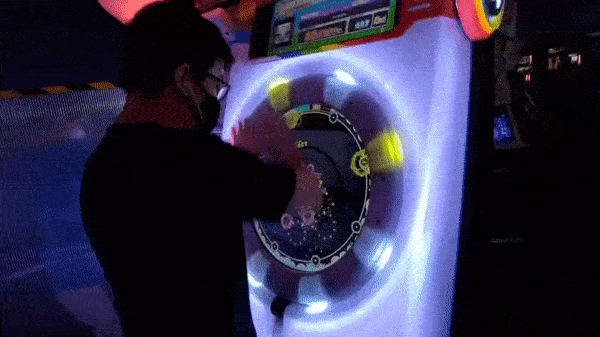
VR Fitness
back to section topBeat Saber was my first foray into VR fitness and I got quite decent at it after about 100 hours of playing, but my wrists started hurting. If you see the more advanced maps, you'll understand why; it’s mostly spazzing your wrists around to hit the flurry of notes. Then I moved on to Synth Riders, Pistol Whip, and OhShape. These have quite a lot of replayability and are quite fun, but generally speaking, they only count as medium exercise. Boxing games in VR are also quite a workout. One problem with a VR workout is that the headset tends to fly off if you do anything too intense. I fixed this problem by making a chin strap for my headset.

Another problem is that you’re either tethered to a computer or you need to buy Meta’s Quest, which locks you into their ecosystem. I don’t like that idea, so I’m still tethered to a computer, but it is quite limiting where you can play.
Ring Fit
back to section topThere are many "exercise games" out there that claim to make exercise fun to keep you exercising without needing to contribute your own motivation. Ring Fit was the first exercise game that worked well as a game as well, and not something that presents itself as a game while being a thinly veiled attempt to mask a repetitive, boring workout routine. It's surprising how many different muscle groups you can train from a bendy plastic ring. The story is not the most interesting, but the haptic and visual feedback you get is as good as I would imagine an exercise game can be given the constraints of an at-home kit.
DDR mat
back to section topI never got into DDR at the arcades, hence this does not fall under the arcade category. Partly because I didn't like the vim layout of the arrows and partly because there were usually people who were way better than me hogging the machines. But I realised that there was quite a decent community around dance mats at home, and I could simply install Stepmania to play and train in the comfort of my home. This is also a very intense cardio workout once you get to the higher levels.

Just Dance (The game, but also actual dance)
back to section topI originally took dance classes so I could work on my self-confidence, but it turned out to be a good form of exercise as well. Practising dance moves, especially higher-paced ones like hip hop, is a whole-body workout. The reason I stopped going to dance classes (besides the pandemic) is that I found out that Just Dance was more fun and also a better workout, with less emphasis on the dance moves and more emphasis on flailing around and getting a score.
I bought the game on the Switch, but I also discovered that there is a mobile version of the game as well. It only costs 40 USD a year too, which is comparable to a gym membership for a month.
As you notice, many exercise-related games are also rhythm games, which is why I also became quite good at rhythm games in general. Nowhere near what you see for those world champions but good enough to make the uninitiated think that I'm good.
VR Gym
back to section topNear my office, there was a VR Gym that made going to the gym actually fun. You put on a VR headset and work out with computer-controlled resistance cables. The more reps you do, the more damage you do in-game. This is the optimal exercise game in my opinion, and I went to the gym 3 times a week. Never have I ever voluntarily gone to a gym so often and I would love to have such a machine in my home. Unfortunately, the machinery is proprietary, and it’s not available for sale. Even if I could buy it, I'm pretty sure it’d cost quite a lot of money, and it takes way too much space. Now that I no longer have an office, the gym has become too much of a hassle to be a regular thing. I love it, but it's not a 3-hour-both-ways-commute kind of love.

Night Cycles with friends
back to section topIt's too hot to cycle in Singapore during the day, and there's also not a lot of places you can cycle that doesn't require you to stop every few minutes for a traffic light. But if you start at Changi Coast Beach and cycle along the park connectors all the way to Marina Bay Sands, you can get a good 60km or so without needing to stop too much, making it a really good workout. This is more or less the same as the running one, forcing myself to go on an exercise by making plans with others so I can't back out. Also, once you start cycling 30km, it's a bit hard to give up halfway, and I'd have to complete it even if I feel like crap. Meaning all I have to do is to convince myself to get to the first 30km and the second half is basically free motivation if I want to get home. (Or I could pay for a cab but I’m too cheap for that).
Mountaineering
back to section topTaking the concept of “free” motivation to the extreme, a mountaineering trip is the ultimate commitment. I have never gone on a mountaineering trip alone because there is no way I'd willingly put myself through that. But with the power of FOMO, I'd commit to a long hike when others are going. This usually involves a whole lot of money with the plane ride and hotels. Then I would also think about all the lovely photos I would get on the hike to convince myself that it’s wroth it. Once I'm on the hike, there is no way I'd be backing out of it with the amount of investment I put in. The next 5 days of hiking will then require no added motivation to complete. There'd be a lot of bitching throughout, but I would still have to complete the hike if I wanted to get home alive. So I exploit my desire to be home in bed again as motivation to exercise.
Trampoline
back to section topOne thing I discovered recently was that trampolining is an extremely intense workout. The exhilaration of jumping and being airborne almost entirely cancels out the exhaustion from jumping for an hour. When I was in Singapore, I went to Bounce once or twice a week to get my airborne and cardio fix. Naturally, when I got back to the US, I looked up trampoline parks. There was a park just 10 minutes from my place, much to my delight. Unfortunately, the trampolines were all mushy and probably tuned for the safety of children. It took most of the fun out of trampolining, and it was no longer a viable exercise option. It wasn't fun, and I still had to drive to the place. At that point, running would have been more efficient.
Other Gimmicky Devices (Activ5)
I've also tried using various apps that track your daily score. One such device is the Activ5. It's a small device you can squeeze, giving you feedback via an app on how hard you're pressing. Surprisingly this provides quite a decent isometric workout. But just like all other exercise devices that pretend to be games, it hardly kept me motivated enough to continue using it.

Overcommitting to Everything
back to topI was terrible at saying no. Not just to other people but even to myself. As I mentioned above, I was always working on more projects than I can handle. Partly because I wanted to do everything, partly because I kept thinking that I could do it if I just sat down and focused. So often have I been told that all I need to do is grow some discipline, and my life would be better. It’s been 30 years, and that discipline still hasn’t shown up.
Learning my limits and knowing what I can handle is something I had to learn by repeatedly failing to meet my expectations. The obvious answer here is to just work on one thing at a time. But doing only one thing well is so boring, and I still wanted to be able to do a bunch of things at the same time. There are so many things to learn and do and not enough time.
Guiding the ebbs and flows of my focus
I was in love with the idea of being able to multitask. That has not worked out well for me at all, and I don’t believe that anyone can be truly good at multitasking. At the same time, I dislike having to commit to only one thing at a time. It felt unproductive, and all the other interests vying for my attention would be sad.
I noticed that my interest in anything would usually only last a while, typically a couple of weeks, before I got bored with it. I would usually juggle 5 or 6 different interests, with about 3 that I would be actively trying to work on at any given time. The compromise I came to was to work on only one thing at a time, but for a short while, say for a week or two.
I noticed that my interest in anything would usually only last a while, typically a couple of weeks, before I got bored with it. On a good month, I would be juggling 5 or 6 different interests, with about 3 that I would be actively trying to work on at any given time. This was obviously unsustainable, and rarely was anything done well.
The compromise I came to was to work on only one thing at a time, but for a short while, say for a week or two.
A real-world example would be this blog post. In this period, I want to finish this blog post, make an app, tidy up my digital backups, finish up my crocheting project, and practice drone racing. I’ve mostly put aside all my other interests right now to write this blog post,
I have found that by doing this, I manage to achieve a lot more within a given period. I also have the benefit of having worked on a few different things in the span of a month, so it never feels monotonous. It still felt like multitasking, but instead of splitting my Pentium 1 brain between 3 tasks simultaneously, I would split it out over time. I wanted to say this is like a time-sharing OS and appear smart, but it’s a bit of a stretch. Since I’ve already spent effort reading the wiki page, the reference is still going to be here.
Scope Creep
Even within a project, I would typically overcommit to its scope. A good example of that would be this blog post. I wanted to write a nice short summary of my 10 years and do it over one long weekend. In the end, it's taken me 4 weeks to write and it has ended up being more than 15k words. I have never written anything close to this length in my life.
Tango Master was a failure because I wanted to achieve too many things at once with that project (learning a new programming language, replicating an existing app, making it my main Japanese language learning app). In fact, a lot of my failed projects could probably be attributed to not having a small enough scope.
Learning to manage the scope of a project has been something that I’ve been working on for the past few years of my life. Unfortunately, I still haven’t figured out how to solve this particular issue and I still have to deal with it.
Notable Failures
back to topThis section is ripe for potential ragging on myself, but for the purposes of this post, I will keep it mostly to projects that I've started and never managed to complete to my satisfaction.
Many of these projects/goals overlap, and I don't remember exactly when I started and stopped each one, but these are ordered roughly by chronological order.
- App Making App
- Pixel Rife Video Review System
- Object Tracking App
- Clockwork'd (Time Tracking App)
- Technology-Assisted Biological Compass
- AML Research
- Etsy Shop
- Piano Hero (Piano Learning Device)
- Mobile Game Studio
- Tango Master (Japanese Flashcard App)
- Being Fit
- Being a Millionaire by 30
- Releasing this blog post on my 30th birthday
App Making App
back to section topI picked up this project for a client shortly before entering the army. The client had a lot of other clients that were commissioning apps. These apps had limited interactivity and were just web pages in the form of an app. Effectively a fancy PowerPoint file. The idea was to create an app with an interface similar to PowerPoint that could be used to make these sorts of apps. The app format would be proprietary, and it would have corresponding readers on iOS and Android allowing it to be packaged and presented as a standalone app. This was in the early days of code-once-deploy-anywhere platforms, and react native didn't exist yet. Phone Gap was an option at the time, but it was extremely janky.
In this period of my programming career, I was more interested in coding new things from scratch than learning to use existing solutions. This project is a prime example of that. I’m very sure we could have used something on the market to achieve the same result; instead, we opted to build it ourselves. It was fun while it lasted, but I had entered the military midway through the project, so it was difficult for me to continue working on this.
Pixel Rife Video Review System
back to section topFrom 2012 to 2014, I had a lot of video projects for a YouTube company under my Pixel Rife agency. The turnaround time for these videos was usually less than a week but sometimes could be as little as 24 hours. One pain point we had was that sending the video drafts via email and receiving feedback was a tedious process that was prone to errors and would add to our turnaround time.
With that, we devised an idea to build a web app that would allow our clients to annotate the videos and add commands at specific timestamps or even on the video itself. The theory was that doing this would improve communication with our clients. I also had a pipe dream that if it was useful enough, we could either sell it or deploy it as an open-source project that other people could use as well.
In the end, this project died simply because we stopped making videos, and there was no longer a need for it. It is a pity because I think this was one of the better scoped out projects which had the potential to be completed.
Object Tracking App
back to section topSince I was young, I've always had problems with not being able to find my belongings. I would be dependent on my mother to help me find everything, and I would go through a dance of searching for my phone or wallet every time I left my house.
I came up with an app that would allow me to track where everything in the house was. The high-level idea was to have a system to let my mother log where which cupboards each object was at home. In effect, I was trying to implement a warehouse logistics system within my house.
This was obviously going to be a failure from the start. I had no good way of tracking everything at my house, short of getting my mum to manually update the locations every time anything was moved. I thought of using QR codes or barcodes to make things easier, but that made things much more complicated than necessary.
This is a classic example of me trying to fit the problem to a solution that I had come up with instead of thinking more clearly about the problem. Younger me was on a high of being able to code, and everything looked like it needed an app. In the end, the solution was for me to move out; since I started living alone, I've had fewer problems keeping track of my stuff since nobody was moving it around.
Funnily enough, this idea ended up being rehashed as Trackpack, the final year module project I worked on. This is mainly because I didn't actually have to code the app but just pitch an idea. (more information in the Notable Events Section year 2017)
Clockwork'd (Time Tracking App)
back to section topYet another app. I was high with power after making one (simple) Android app.
I've wanted to track my time since 2012. At that point, it was more because I needed to keep track of the work I was doing for clients rather than generally tracking my life. Of course, my first instinct was to come up with my own application rather than to find a third-party solution. I was certain that no existing application would be able to do exactly what I wanted.
I spent an inordinate amount of time designing the user flows and cool interfaces. I was more excited to come up with unique components requiring me to code from scratch rather than finishing the app. In the end, my motivation cycle came to an end before I could even start coding.
I ended up only starting to track my time in 2017, five years after my initial idea, using an app that was on the Google Play store. (Ironically, this is the situation I’m in right now since this has seemingly been discontinued, and I might need a new one)
Technology-Assisted Biological Compass
back to section topIn about 2017, I came across the idea of neuroplasticity. One of the possible uses was something about being able to give yourself a sense that humans otherwise do not have. In this case, I saw a product on Thinkgeek called north paw. The device would supposedly “add” a way to sense where north was. It went around your ankle, and a section would vibrate, indicating where north was at all times. The brain would eventually tune out these vibrations and give you a new "sense" so that you always "knew" where north was.
This was something I found really cool, but I think that the price of the kit was $150. As a poor student, I could not afford to spend $150 on such a frivolous toy. Instead, why not try to replicate it for cheap with an Arduino and some sensors?. How hard could it be? As you can imagine, I ended up spending almost $150 just to get a prototype that did not work. I could not figure out how to make only one part of the anklet vibrate as opposed to the entire thing. At this point, I had spent too much time and money to make it worth the effort anymore, and I dropped the project
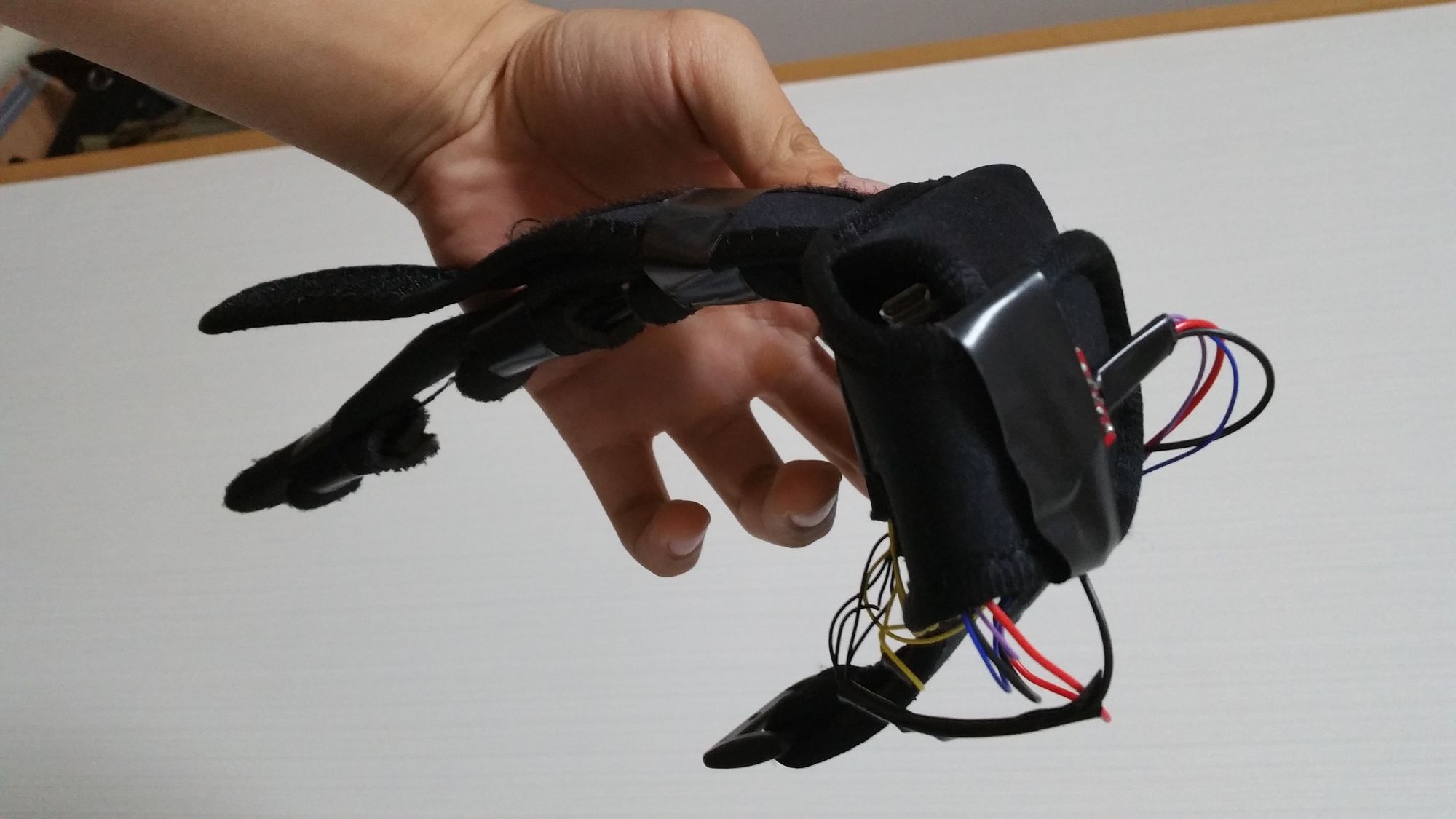
AML Research
back to section topAt some point, my cousin was involved in some AML (Acute Myeloid Leukemia) research. Specifically figuring out if we could detect AML with a small blood sample. I was roped in to write a program to run some analysis on datasets that we were given. While we managed to get some potentially good results, the datasets we were provided were only of patients with AML and none of the healthy patients. That meant that our results weren't conclusive, and the project died down once we went on a vacation.
I also stupidly used java because I thought that it was faster than python. It proved to be much slower to write anyway, and I couldn't really iterate quickly on the project when we needed to.
Etsy Shop
back to section topAt one point, I wanted to make some passive income or have some form of a second income stream. This was around the time when my company was failing due to covid, and I realised that I might be losing my job soon. I didn't take that very seriously, but it inspired me to create an Etsy shop.
I wanted to be able to sell the cool things I made, more to share my creations with others, and less to make money.
I came up with 3 completely different ideas.
- Painted Topographical Maps: but those took too long to paint each one.
- 3D Printed Wooden Keycaps: these were easy to manufacture but did not look very nice until I sanded them down, which too long.
- Laser Engraved City Maps: Easy to manufacture but anyone can make it, so the competition was too high.
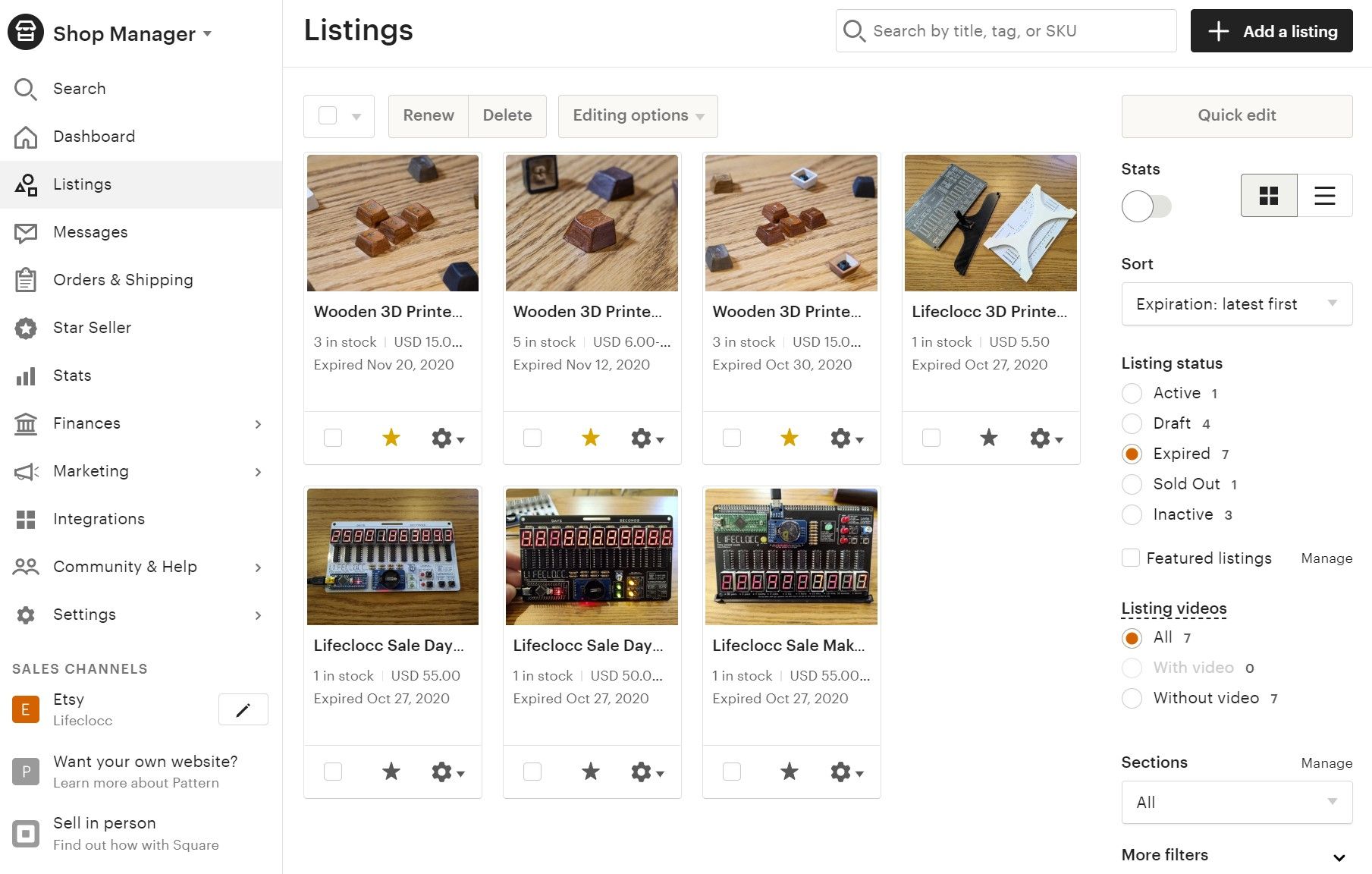
The solution to this wasn't actually an Etsy shop but rather a Kickstarter project. It gave me the orders and money upfront and made it much easier to fulfil all those orders at once instead of having an online store where the orders trickle in every couple of weeks or so. Unless I was planning on making my Etsy store my full-time job, then I could work on marketing and getting a constant stream of orders.
Piano Hero
back to section topI've always wanted shortcuts in life. I learned piano as a child and gave up pretty early because lessons were tedious and boring. When I started picking it up again as an adult, I wanted to learn music from games or shows that I liked, but I did not want to learn how to read sheet music. This was when I came across Synthesia, a program that would show me the notes to press in a format much like how Guitar Hero is played. it allowed me to learn to play the piano without actually learning sheet music and I think it worked out pretty well. (Unfortunately, all the evidence on my YouTube channel has been destroyed by lawyers.)
One thing I did not like was how the notes did not line up with my keys. I had to use Synthesia on a tablet, so I had to squint to see which keys the notes were coming down on, and there were 88 keys to hit. Like rhythm games, I wanted to see the notes coming toward my fingers, so I could press them when they reached the keys. Some pianos will light up the keys to let you know which notes to play, but you cannot see what notes are coming up. There was a nice prototype that used a projector to project the notes coming to your keys, achieving the desired effect. Unfortunately, these were custom made pianos and not something that could fit on any piano.
I spent a lot of time trying to figure out how to make a device that would work with any piano. It needed to have some sort of screen to show the upcoming notes. In the best-case scenario, I would simply have a long screen that fits across all 88 keys. Unfortunately, I could not figure out how to do this, so I settled on a bunch of addressable LEDs.
Then I got stuck trying to figure out how to decode midi files on an Arduino before losing the motivation to do this project. I still like this project, and I think it has the potential to make a comeback in my motivational cycle. Still, I do believe I am severely limited by my hardware knowledge.
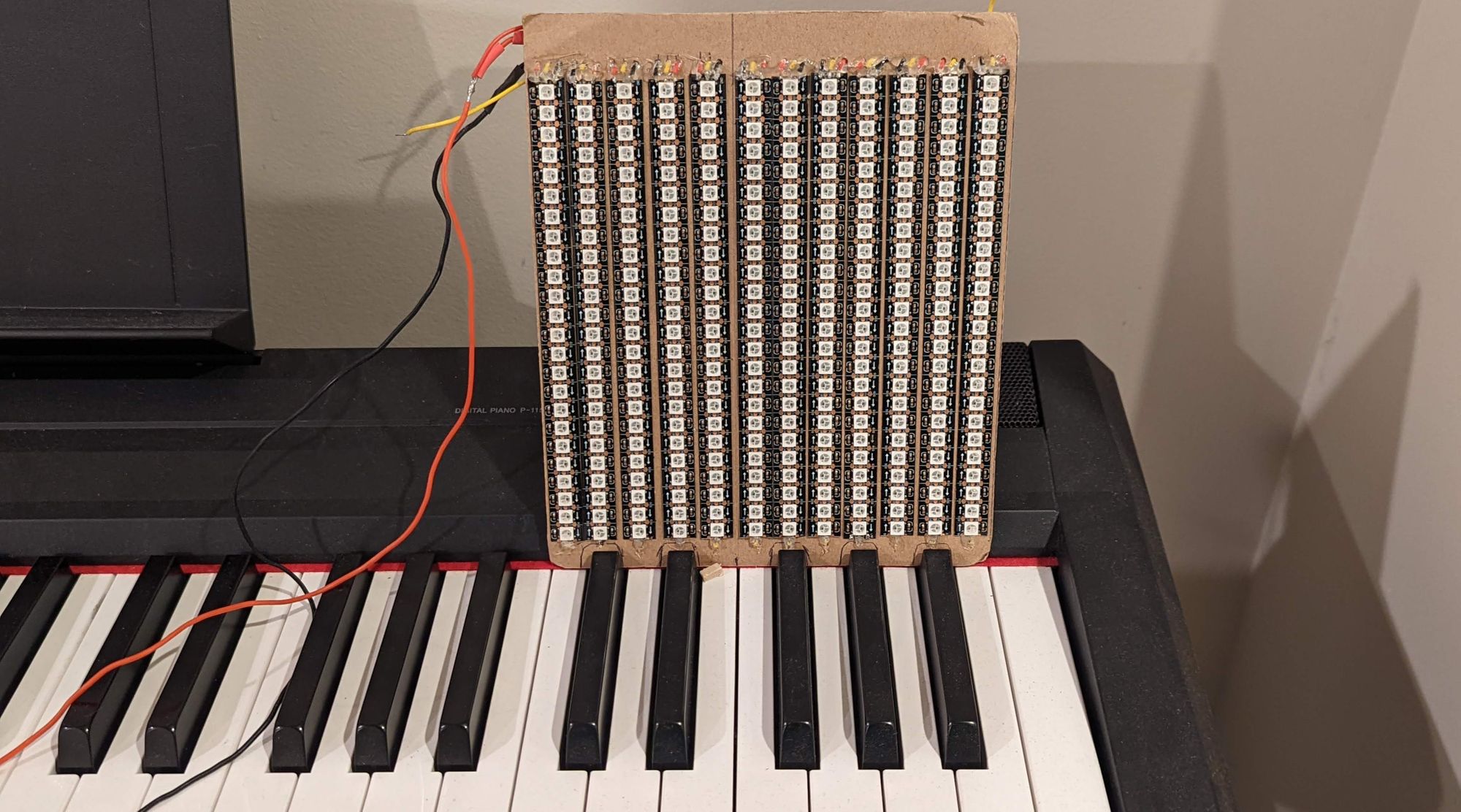
Mobile Game Studio
back to section topI have a diploma in games creation, so why am I not making any games? Well, mostly because any serious game takes way too long to develop, and my attention span is not conducive for such an endeavour. But what if I just made simple, shitty games and released them on the Google Play Store? That was the idea I had in 2020. I started making games on a framework called Corona (yes, it's an unfortunate name, and it has now been renamed Solar2D) and even managed to get 2 somewhat functional games. The games weren’t even that horrible, and I daresay it was fun to play.
So why are there no games released? Well, mostly because I started to get a bit greedy and wanted to add ads to the games. I figured that this would be potentially a source of passive income for me if I managed to get ads working and I kept churning out simple stupid games. I banged my head on the wall trying to get ads in for a while, and when I couldn't get it working, I gave up and moved on to something else. That was unfortunate because the gameplay was complete, and the only thing not working was the ads.
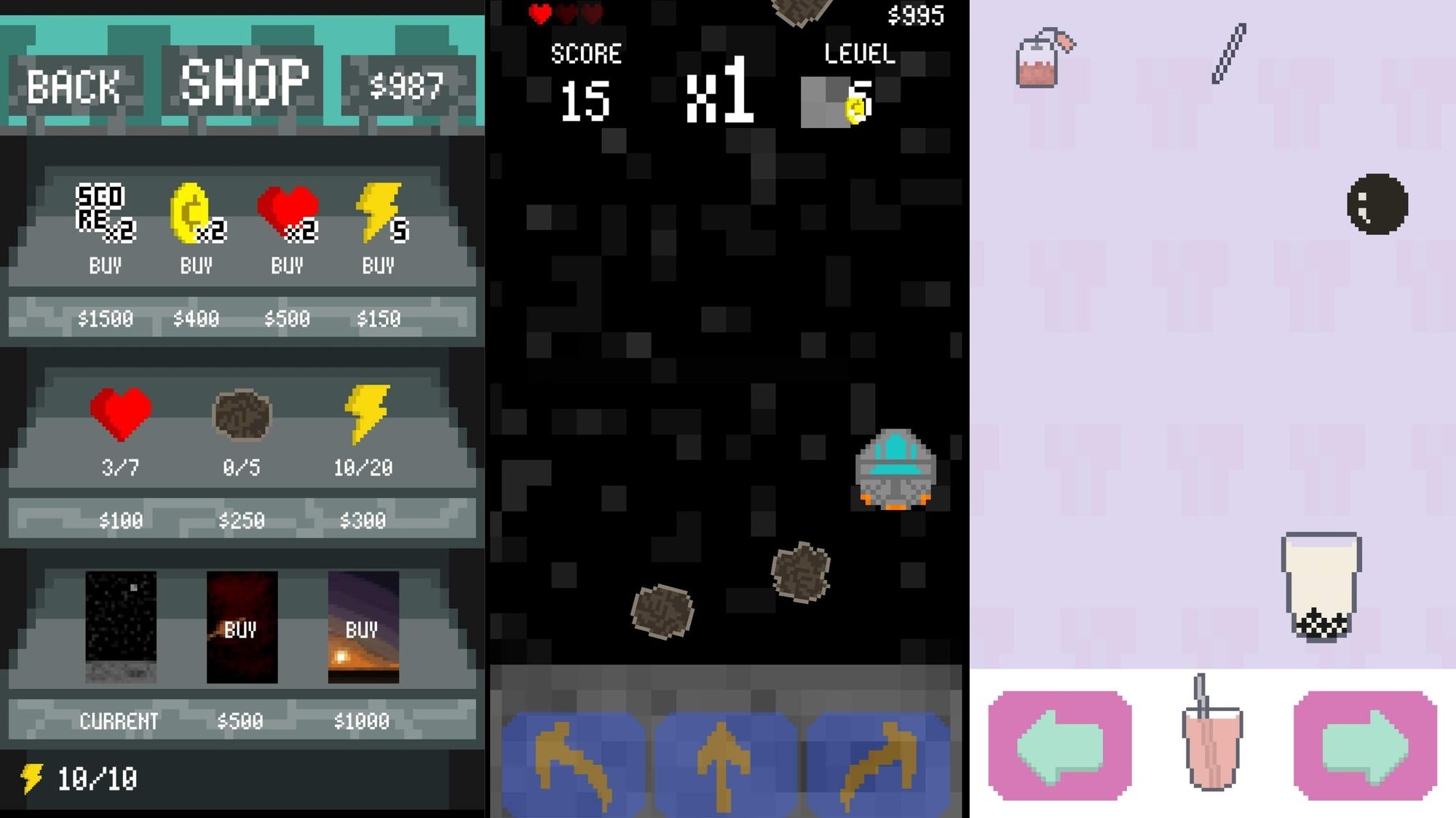
Tango Master
back to section topThis has been my biggest failure to date. A long time ago, when Windows Phone was still a thing, I used an app called Tango Master. I loved it so much that I even wrote a whole blog post about it. As we know, Windows Phone went the way of the dodo, and I was left without an app to learn Japanese. Yes, there are other flashcard alternatives, but I had issues with them and it killed my motivation to learn Japanese.
It might have just been an excuse, but my solution was to remake it on Android. At the same time, this seemed like a great opportunity to learn Kotlin and Android's new MVVM paradigm. That was my first mistake; learning a new language and trying to implement such a big project slowed my development speed a lot. I would spend an entire day just to make a single element appear on the page. This did not do any favours for my motivation. The project was part of my massive list of projects for a couple of years, and I never really made much progress, until a really cool thing happened.
I somehow got into contact with the original creator of the app, who was living in San Francisco at the time, and not only did I get the permission to use the original name and assets, but he also gave me the source files of the app. This gave me a huge boost in motivation, and I started working on it again, only to be hindered by knowing nothing about the new Android paradigm. This motivation lasted a couple of months. It was mostly killed by the fact that I would spend a few hours working on the app just to add a single button. When coding in more familiar territory, I would typically be able to code large swathes of features in a day.
A few months later, I gave up on that 3-year-old code base and decided to redo the whole thing in React Native. At least that would be closer to web development, something that I'm more competent at. I wrote another blog post about setting that up, and I even got to a point where I recreated all the functionality in the previous app in a week. Unfortunately, it turns out that I still did not fully understand how to deal with phone databases and loading the database would have taken a few minutes. This was an unacceptable dealbreaker, and I finally gave up on ever being able to recreate the app on mobile.
It took me 5 years and many rewrites to finally call it quits and take a look at the actual problem I had. I was using this app as an excuse for my lack of motivation to study Japanese. I eventually succumbed to Duolingo and just started using that one instead (of which I now have a 300+ day streak)
Being Fit
back to section topAt one point in my life, I was 65kg. That point was when I was starving myself and exercising 3 times a day (in the army). That was an unrealistic expectation to have, but I have always told myself that I would like to get back to a healthy weight and fitness level when I'm 30. It's hard to have a good measure of fitness, and weight is a very inaccurate measure, but I had a goal of 75kg set for myself by the time I hit 30.
As I got closer to the deadline, I figured I could do 76, then 77, then 78… Finally, I gave up and decided that I'd be happy so long as I was below 80kg. I was doing pretty well till the week before when I hit 80.1kg on the day itself. I guess I'll have to chalk this up as another failure of mine.
Being a Millionaire by 30
back to section topAnother pipe dream that I never actually spent any time or effort working towards. I was banking on my startup going public and me getting all the stonks. Well, covid and other undesirable world events happened, so my stonks became not stonks, also I'm supposed to be thankful for still having a job. Nevermatter, I shall still find a way to be a millionaire.
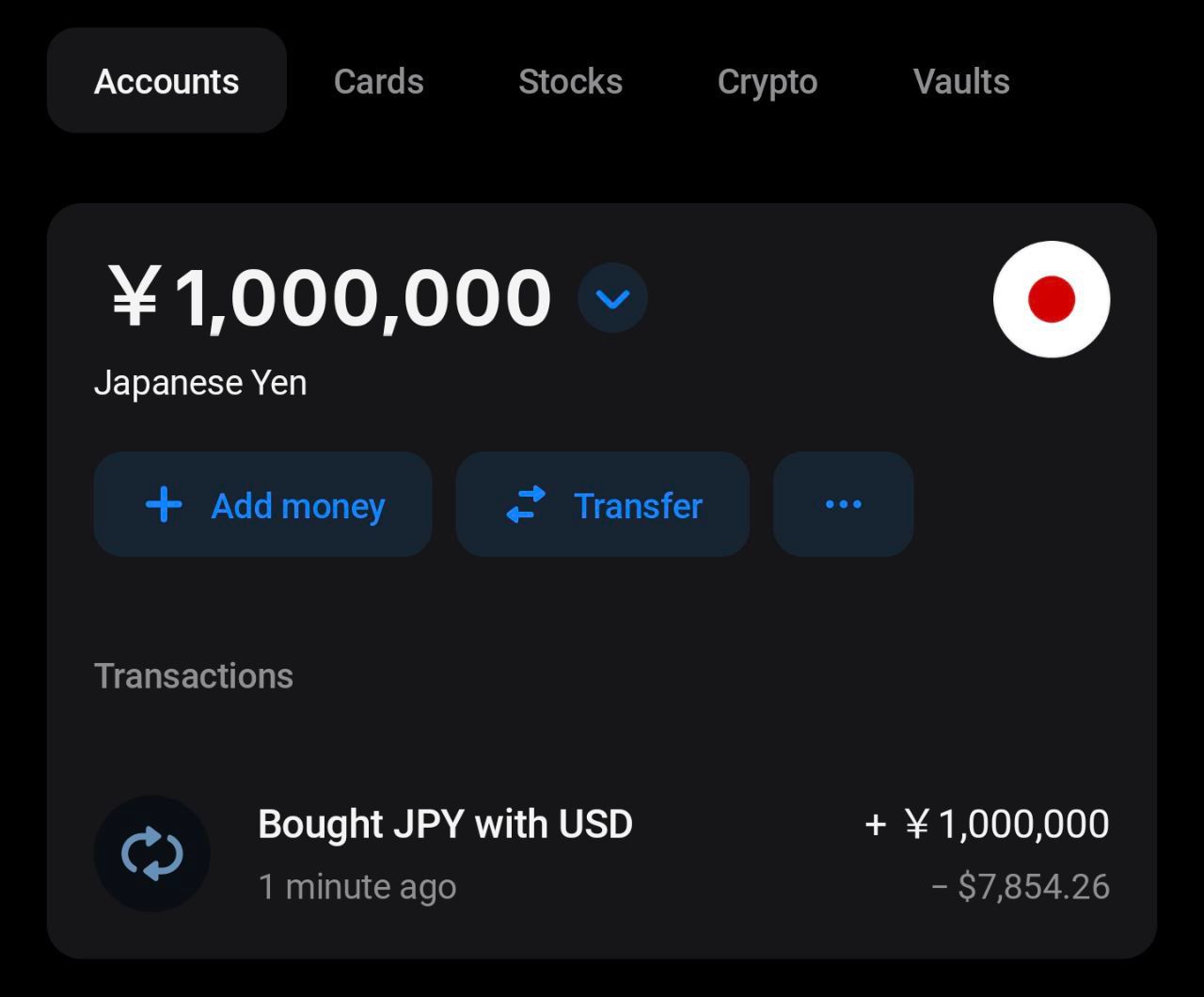
So technically, this was not a failure. And yes, I did just waste a bunch of money on exchange fees, changing my money to yen to take this screenshot and feel good about myself. Also, if you reframe it as an investment, I didn’t waste any money either!
Releasing this blog post on my 30th birthday
back to section topEven this blog post was a failure. I had such grand plans for releasing this really cool blog post and analysis of my life with all the data that I've collected over the past 10 years on the day I turn 30. But due to a mix of procrastination and panic and the emotional stress of turning 30, I failed this goal.
Not only did I have to cut down the scope of the post, but I also did not even manage to finish writing it. I had severely underestimated the time it would take to research and write this post and only seriously started writing it a week before my birthday. Looking for photos was also something I had completely neglected to take into consideration. That being said, at least I still managed to release within the same year.

Over the past few months, I have occasionally been writing down notes and trying to think of a coherent story to tell. As I went through this process, I kept discovering various projects and things that I’ve done which added to the post. Then, I spent about 50 hours writing, collecting pictures, and doing graphs in the last two weeks. Overall this took longer than the one weekend I hoped to complete it by (refer to the section on underestimating workload), but I’m happy I managed to keep my focus on this long enough, and it didn’t become another incomplete project.
